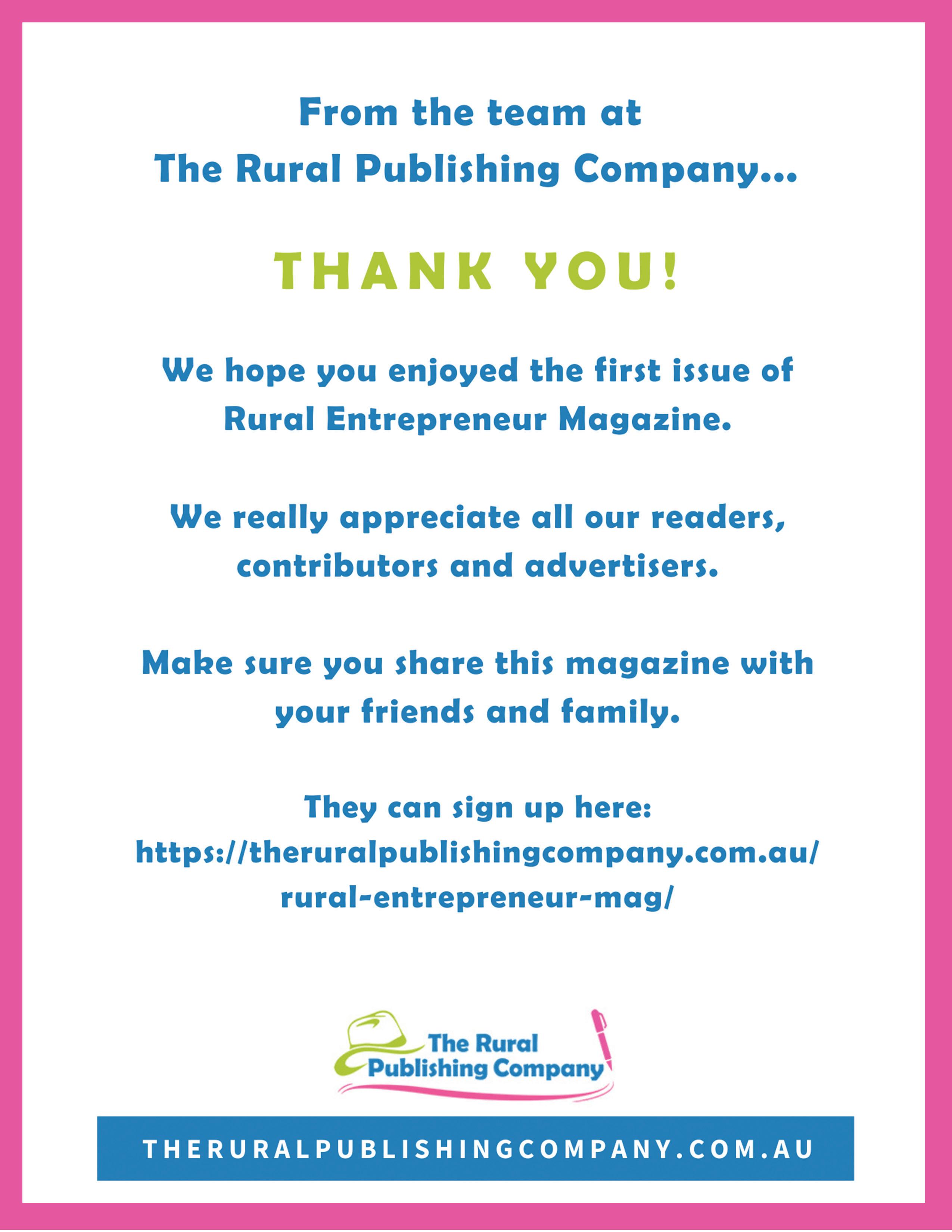








asking questions. You never quite know where these relationships and connections will lead, or what opportunities they may bring. But even if they don’t bring you anything, it still helps you to FEEL connected and learn from others.
We’ve found, particularly over the last few years, that we get a little stuck in both business and life, when we don’t take the time to connect with oth er business owners. Connection with like-minded people really matters.
Wow. We’ve been really blown away to the response we’ve received since releasing Issue 1 of Rural Entrepreneur Australia.
There’s been such great feedback, and so much interest to contribute content and get involved. And we’re so excited to bring you another jampacked issue.
We’d love to thank all the incredible business own ers who have taken the time to put together such fantastic articles. Being able to put together such a diverse range of stories, insights and advice is so powerful.
It’s also certainly safe to say that we’re learning from all of you too!
Something we’ve been doing differently the past month or two, is actively getting out to in-person networking events. This is something that’s not al ways easy to do when you’re regional as there’s so much travel time involved. It’s also not easy with younger kids and having to arrange babysitters.
However, as it has been ‘small business month’ with lots of events across Ballarat and Geelong in August (we are basically situated in between both!), we thought we’d make the effort to con nect one on one with more people in real life. (And yes, we’re incredibly fortunate to have supportive grandparents at hand!)
As you’ll learn in Angela Pickett’s networking arti cle, networking isn’t just about collecting business cards or handing out yours to as many people as possible. It’s not about sales or meeting targets. It’s about creating genuine connections and build ing relationships. Whether they can directly help your business or not. It’s about helping others and
And while you honestly can’t beat that in-person relationship building and connection – finding ways to connect digitally is the next best answer. Which is precisely the inspiration behind Rural En trepreneur Australia.
The more you can gain insights from other region al business owners – the more connected you feel, and the more you learn and grow. Both personally and professionally.
Someone else might have an idea that helps you to see a challenge differently, that then gives you the breakthrough you needed.
Learning about a new marketing tactic could trans form your business.
Something that seems impossible alone, might be completely doable with the right collaboration. And seeing someone else running a successful business, proves that it can definitely be done. We hope you find the information in this issue helpful.
As always, if you have any feedback or sugges tions for us on content, design or anything else, we’re all ears.
While I (Sarah) have written for and helped with other magazines over my career and business journey – this is certainly the first time we’ve cre ated and managed one ourselves. So, all wise words are always appreciated. Thanks so much,
Resilience is a word we hear a lot lately, especial ly in the context of business.
After riding the rollercoaster of a pandemic for near ly three years, resilient businesses have proven them selves as the ones that can respond to change quickly, evolve to new environments, and stay attuned to what their customers want.
For me, resilience is not just about business, it’s a way of life.
Ten years ago, I hit absolute rock bottom.
A few years previously, I’d suffered a major blow to my health and lost my job as the CEO of a charity. Soon after, I lost my beautiful mum to cancer. And just when I thought things couldn’t get any worse, my daughter Molly was killed in a tragic accident on our property, just outside of Wollongong in regional NSW.
To say I was struggling to cope with the weight of my grief is an understatement. I felt lost and completely in the dark.
If you’d told me then, that ten years later I’d be writ ing this article, reflecting on my journey in business, I wouldn’t have believed you.
But eventually, I crawled my way out of the darkness, and reconnected with the sparks of light around me. The grief is still there, every day. It’s part of my life land scape, but it’s not the only thing I see anymore.
If my past challenges and losses have taught me any thing, it’s to never take anything for granted, to expect the unexpected, and to remember each day is a gift.
When I was inspired to start our first business, Pose
idon Animal Health, in 2017, I had no idea how big it would become, or the positive impact it would have on thousands of horses and dogs.
It began as a solution to a pain point for myself, or more specifically my horse Cruz, who was struggling with his health.
In my own personal recovery, I’d become aware of the power of gut health in helping us cope with mental and physical stress. By healing my own gut health, I’d helped myself build personal resilience, to cope with the stress of my grief, and to reclaim my own overall health.
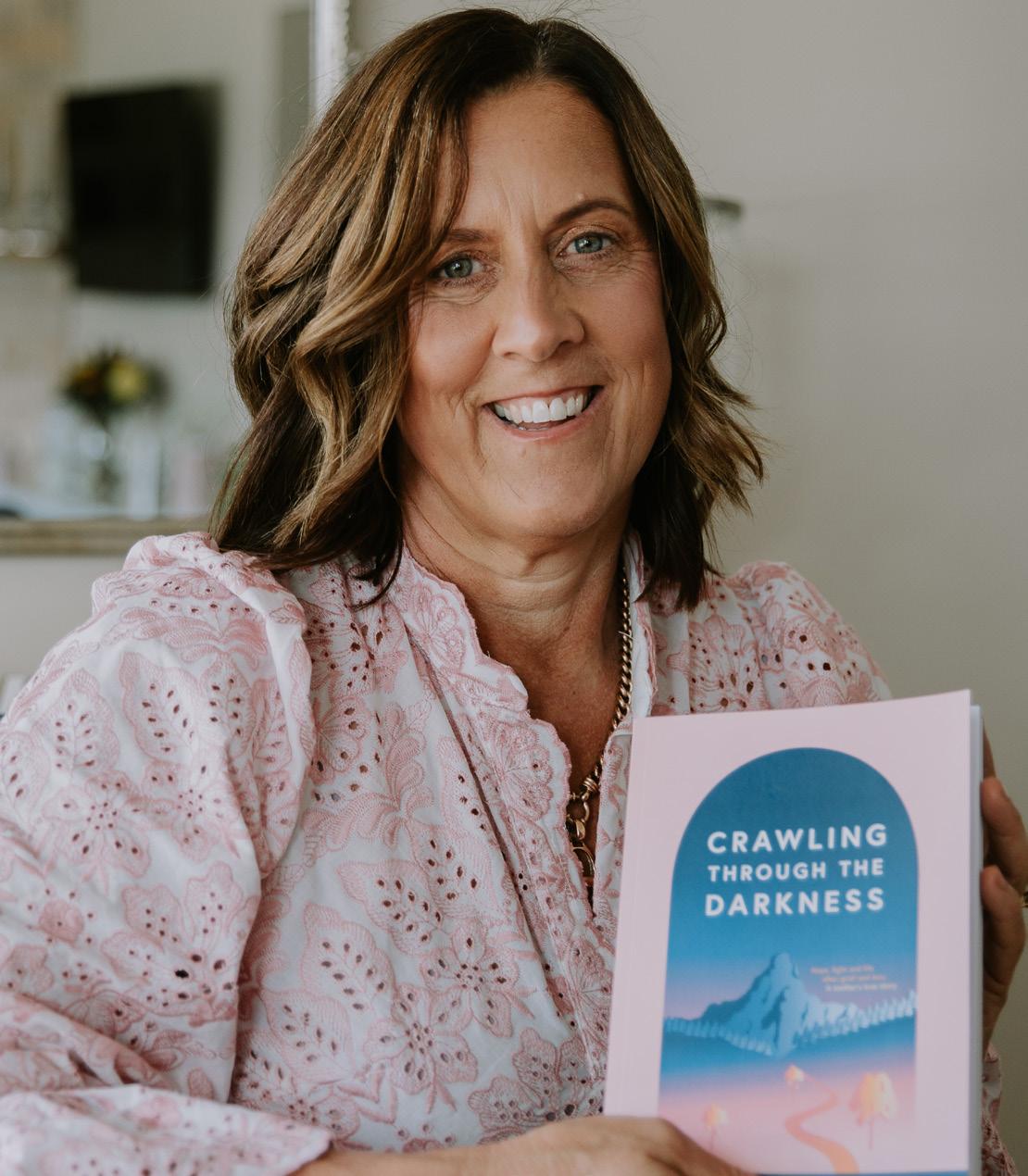
Knowing what I’d learned about gut health, I wondered if helping Cruz with his gut might also help him with his health.
It soon became apparent that other horse owners had the same pain point, and that the right ingredients com
bined with education on feeding and horse care, could make a huge difference to horse gut health.
But the journey to business success is never a straight line, and while we’ve built a successful business in Po seidon Animal Health, new challenges are always ap pearing.
Being resilient as a person and in business doesn’t just mean ‘staying strong’ and ‘soldiering on’ no matter what. Resilience means knowing when to press pause, or to realise when something isn’t the right path. To know that when a door closes, a window usually opens.
As our business has changed the landscape of gut health supplements for horses, and now also dogs, it’s led to an influx of competitors. This means we’re al ways having to reinvent our marketing, sales and busi ness strategy.

Resilience means not always relying on what you’ve al ways done. It’s about being open to change, and grow ing and evolving as a business.
To do this, I recommend being a lifelong learner.
The global business landscape is changing all the time, and there is always something new to learn, or a new opportunity to grasp. When we started our business, we were early adopters in our field of using Facebook as a place to proactively connect with our customers, creating a community of horse lovers and owners who came to us for an opportunity to learn about horse health, and meet like-minded people.
Today, we’re still proactive in our use of social media, but we’ve also expanded our marketing approach to be more targeted. We use email marketing to help our customers with tailored information, and have updated
our website so that it’s user-friendly and helps our au dience understand why our products are effective, and the evidence behind each of our formulas.
That said, to me business resilience is also about build ing a team of people you can trust – either employees or contractors – and understanding that you don’t have to be the expert in everything. Sometimes it pays to hire experts, so that you can focus on the parts of the business that only you can do.
If you’re a rural or regional business owner reading this, embracing a resilient approach to business could mean making one change today that sets you up for success.
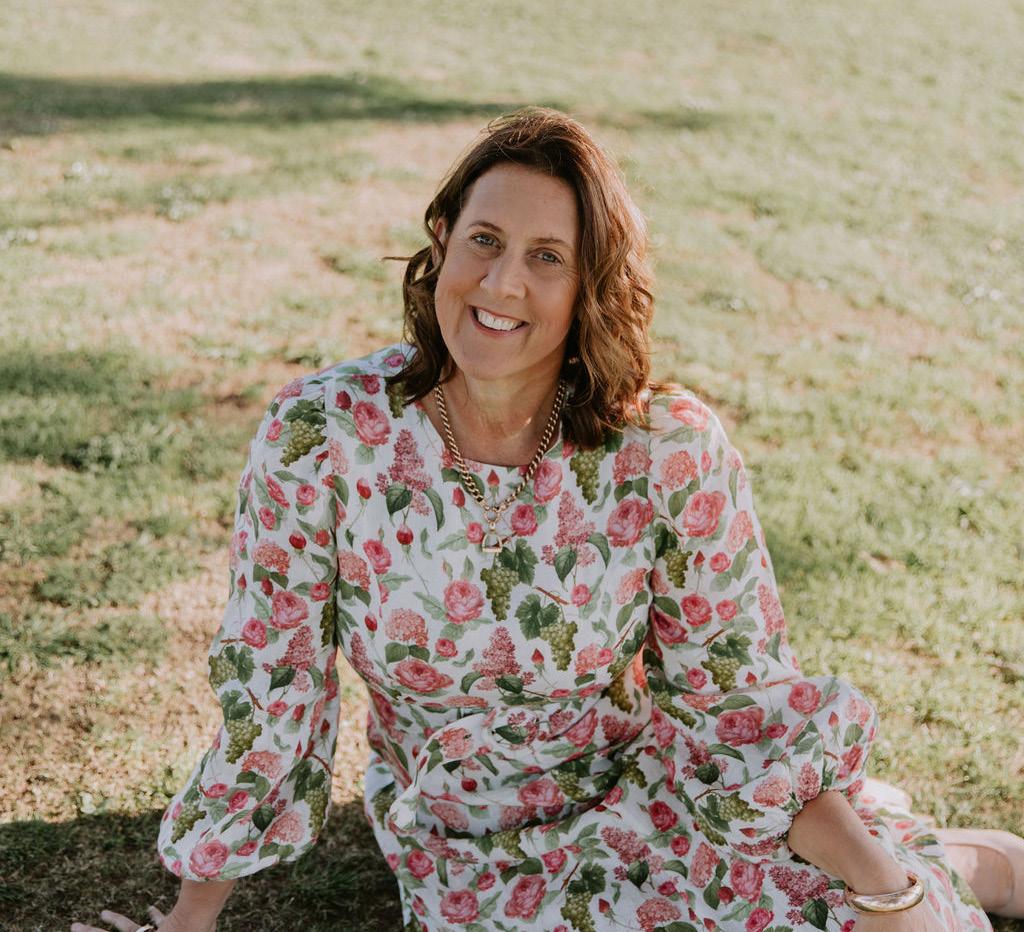
Perhaps there’s something you’ve been pushing uphill that it’s time to let go of, so you can focus your en ergy on a different business opportunity. Or perhaps it’s about proactively reaching out to another business that you can build a partnership with – combining your customer reach and building mutually-beneficial op portunities.
Whatever you take away, try to remember how lucky we are to be business owners, forging our own versions of success.
Your success will never look exactly like someone else’s, but that’s part of the beauty of being an entre preneur. Who knows what the next chapter will bring? I can’t wait to find out.
Find out more about Linda and her book, Crawling Through the Darkness, at: https://lindagoldspinklord. com.
Or visit Poseidon Animal Health at: https://posei don-equine.com.
Build it and they will come’ is certainly not a busi ness strategy that many experts would encour age or recommend. However, it certainly seems to have worked for us.
Like many small businesses, ours have started out by providing a solution to problems that we have noticed in our amazing rural community of Cohuna, Northern Victoria (population 2000).
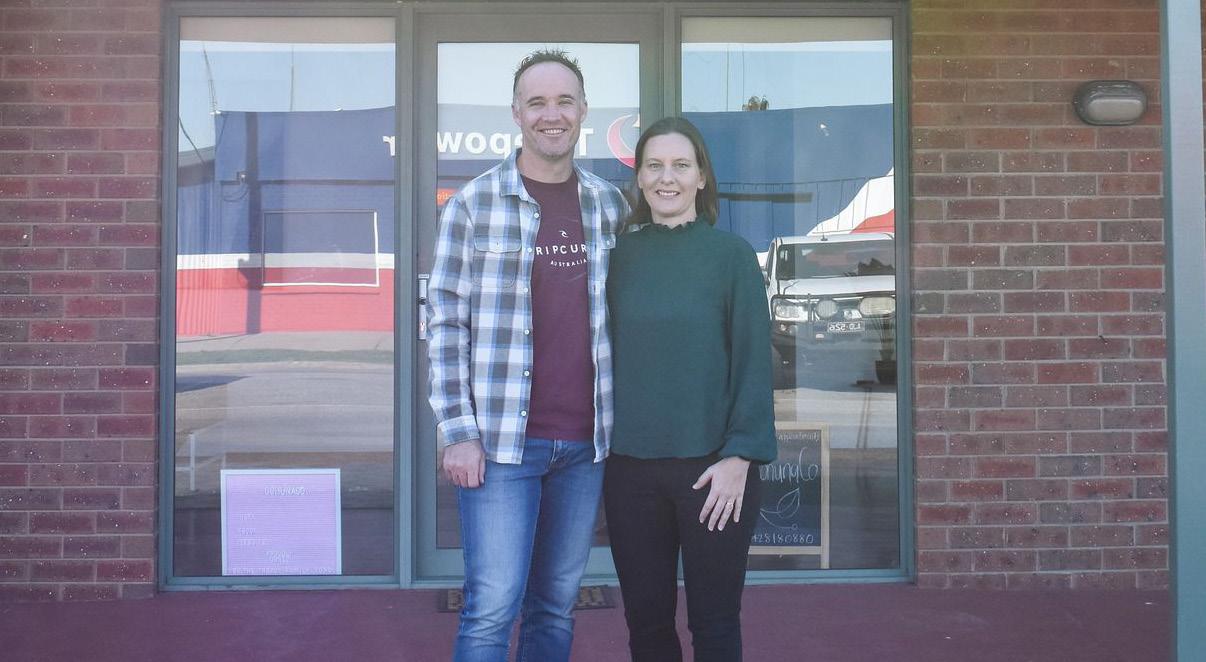
I’m Amy Treacy, and along with my husband Shannon, we have so far created three successful start-ups in the past 6 years. We are honestly just very average people with a growing family and two regular jobs, but we love our town, we have lots of ideas and we are passionate about the success of rural and regional areas. We have never let our lack of business knowledge, relevant qual ifications or anything else stop us!
It all started when our teenage son needed a job but wanted flexibility around his sporting and social com mitments. All three of us put our entrepreneurial brains together and, after a bit of market research, we realised that there was a gap in the odd-jobs and home help services in our local area.
Voila! My Handy Helper was created and business was soon booming so much that we couldn’t keep up with the demand. We ended up selling this business to a lovely local couple (who have subsequently sold the business too). However, we still feel proud when we see the logo on the blue ute driving around town. We’re incredibly happy that something we created together is still serving people who need this support.
The timing of the sale ended up being a blessing in disguise as the next year was quite tumultuous. Our young daughter unfortunately developed severe men tal health issues. We spent much of 2018 driving all
over Victoria to medical appointments, accessing health services and really just having a terribly tough time.
One thing we observed during this period was the huge toll on us, not just mentally but financially. All of the driving to other towns to access support services meant that we were taking a lot of time off work, she was missing a lot of school and we were spending a lot of money in the larger centres while we were there for all of the appointments.
As people who have always advocated for our community and have supported the ‘shop local’ initiatives, this left us feeling very torn. It also made us realise that when small towns don’t have these services available it takes people (and their dollars) out of our local econ omies, which is what all rural and regional towns have been working hard to avoid!
Once our lives settled a bit we were inspired to take some big action based on our experiences. There had been an unused building in town for a few years and we decided to inquire about purchasing it. Fortunately the owner was ready to hand over the reins of the building previously known as ‘Crystal Paradise’ (that’s a story for another time!!) and we were ready to unleash our crazy idea on our conservative little town.
Now, please understand that this was early 2019 (pre-pandemic!) and sometimes new and unusual con cepts take a while to catch on in the bush…but this was a real doozy. We announced that we were creating a coworking centre called CohunaCo, which would be set up for hot-desking and flexible hire spaces.
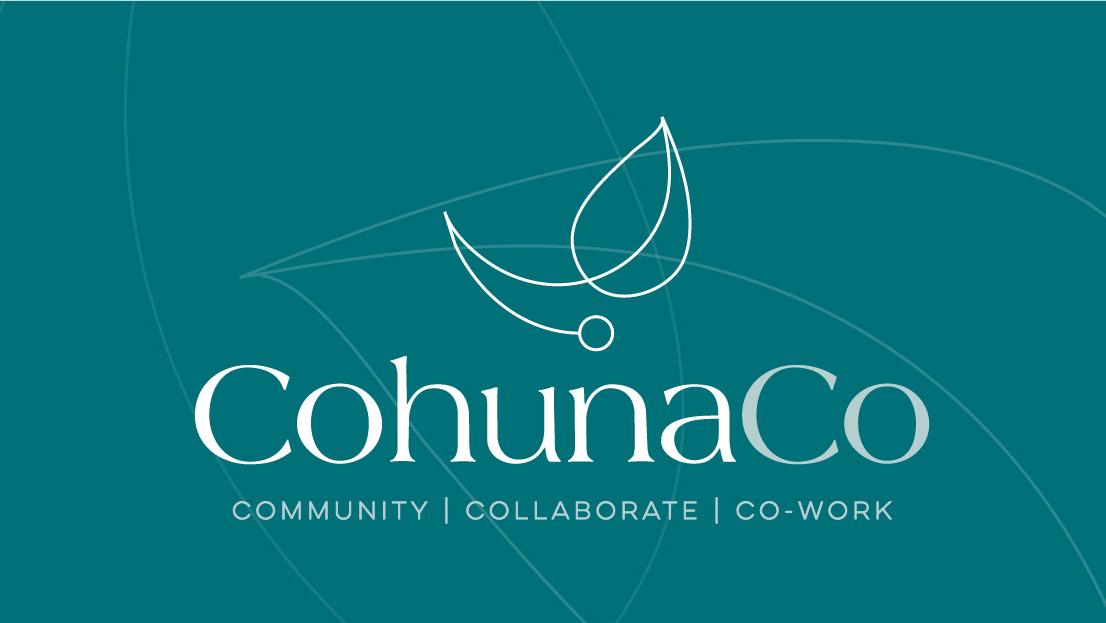
“A what???” was the echo in the many ensuing con versations, and it took a lot of convincing that this business idea might be worthwhile persisting with. At times we did wonder if we had actually made a really

big mistake, but we knew that our intentions were good and that the need was there, even if no one else real ised it yet. We built it – we then just needed to fill it! Our two-year goal was to attract a psychologist to our town as the nearest ones were based 45 minutes away and their waiting lists were already lengthy. We knew that the possibility of finding a full-time clinician would be very unlikely, so we focused on those nearby who might be interested in doing an outreach service once a month.
Much to our delight, Dr Naomi Malone from A Life Sim ply Lived Psychology jumped straight on board and became our very first regular tenant. At one point her business was seeing clients twice a week at our centre, and we were absolutely stoked.
Then Covid hit and, like the rest of the state, we were shut down and unable to trade. The hit was hard at the time, but on the flip side we were able to accommodate both of us ‘working from home’ at the centre as well as having plenty of room for our three teenagers to com plete their remote learning. Thank goodness for great wifi, an amazing coffee machine and plenty of space.
The other blessing in disguise is that now everyone knows what coworking is and many more people are working remotely and flexibly. It seems that we were a little ahead of our time, but that meant we were able to jump straight back into catering for remote work ers, Zoom meetings, online studies, socially-distanced events and so much more.
Over the past twelve months we’ve hosted all sorts of different events, workshops, pop ups, city-based work ers and other visitors. One of our permanent tenants needed to return from a maternity break but didn’t want to be based at home anymore so she has set up a mas sage studio in one of our spaces. Another new busi ness has decided to base themselves at CohunaCo and we’ve welcomed several other important outreach services which either did not previously exist in our
community, or who had trouble finding suitable places to meet with their clients.
One of the biggest wins was that people started look ing to us for business advice and assistance, as com munity-minded local people with little prior experience but with a big success story.
Due to this, we were able to start up a business net work and support many local entrepreneurs who pre viously felt disconnected and overwhelmed. This led to yet another creation that hadn’t previously existed locally, a business support service!
Bush Biz Boost is now my full-time job. The demand for holistic business support with a rural focus is quite large, especially after the past couple of years and the associated burnout that many small business owners are experiencing. I get to offer my range of life expe riences and knowledge to help stressed-out entrepre neurs to find solutions and to feel more connected to their community.
This new business has been driven by demand for as sistance with navigating the online world, increasing digital capabilities, educating people about how to start a new business and by providing social media management and marketing services for those who don’t have the capacity to learn it all themselves.
Although I’ve just moved to full-time work in this space it’s obvious that there is a huge need for this type of service in rural and regional areas. Bush Biz Boost is certainly going to allow me to combine my love of entrepreneurship, rural business, technology and con necting people.
Hopefully these little stories of unexpected business success arising from identifying simple problems that our small town was experiencing, are a source of inspi ration for any budding entrepreneurs out there! Just because you are in the bush doesn’t mean that you or your community must miss out on anything –there are endless opportunities right under your nose regardless of where you are based. Keep it simple, connect with your community and then build it, and they will come.

Amy Treacy is a self-confessed ‘ideas factory’ and a leader in the rural entrepreneurship space. With three successful start-ups under her belt, along
with over a decade working in a local corporate busi ness, her wide range of life experiences lend them selves to her holistic-yet-simple approach to creating, growing and adapting small rural businesses.
With the ultimate goal of leaving her ‘empty nest’ in a few years and taking Bush Biz Boost on the road throughout rural and regional Australia, Amy’s passion for teaching, supporting and building the capacity of small business owners makes her someone to watch as she develops her leadership in this space.
Bush Biz Boost is currently developing programs and events to help start-ups and people new to small busi ness ownership, as well as offering assistance with social media management and digital growth. Please reach out to Amy via her website or social media as she loves a good chat and to hear the stories of busi nesses in the bush.
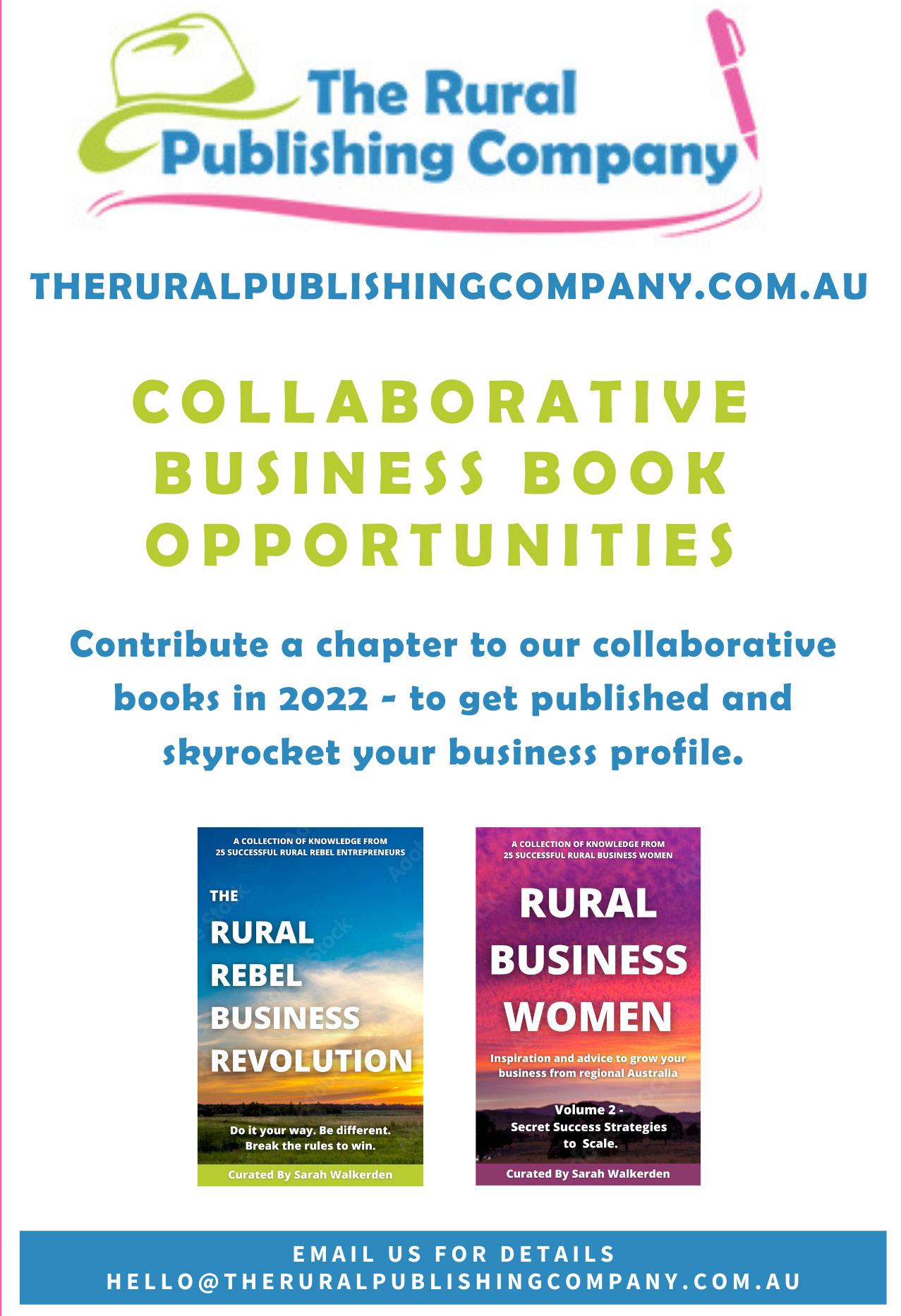
My wife and I migrated from the big smoke to the coun try 4 ½ years ago.
While our roots are in rural areas, up to that point we had spent most of our adult lives in urban areas pursu ing our professional journeys. However, we welcomed the opportunity to move away from the hustle and bus tle of a metropolitan existence and into what we hoped was a more sedate lifestyle.
We have found that lifestyle to a large degree – with some unexpected (and mostly good) surprises along the way.
I was operating a small counselling practice in Bris bane before we relocated and expected to encounter some differences in re-establishing my business in a rural context. As I reflect on the experience so far, here
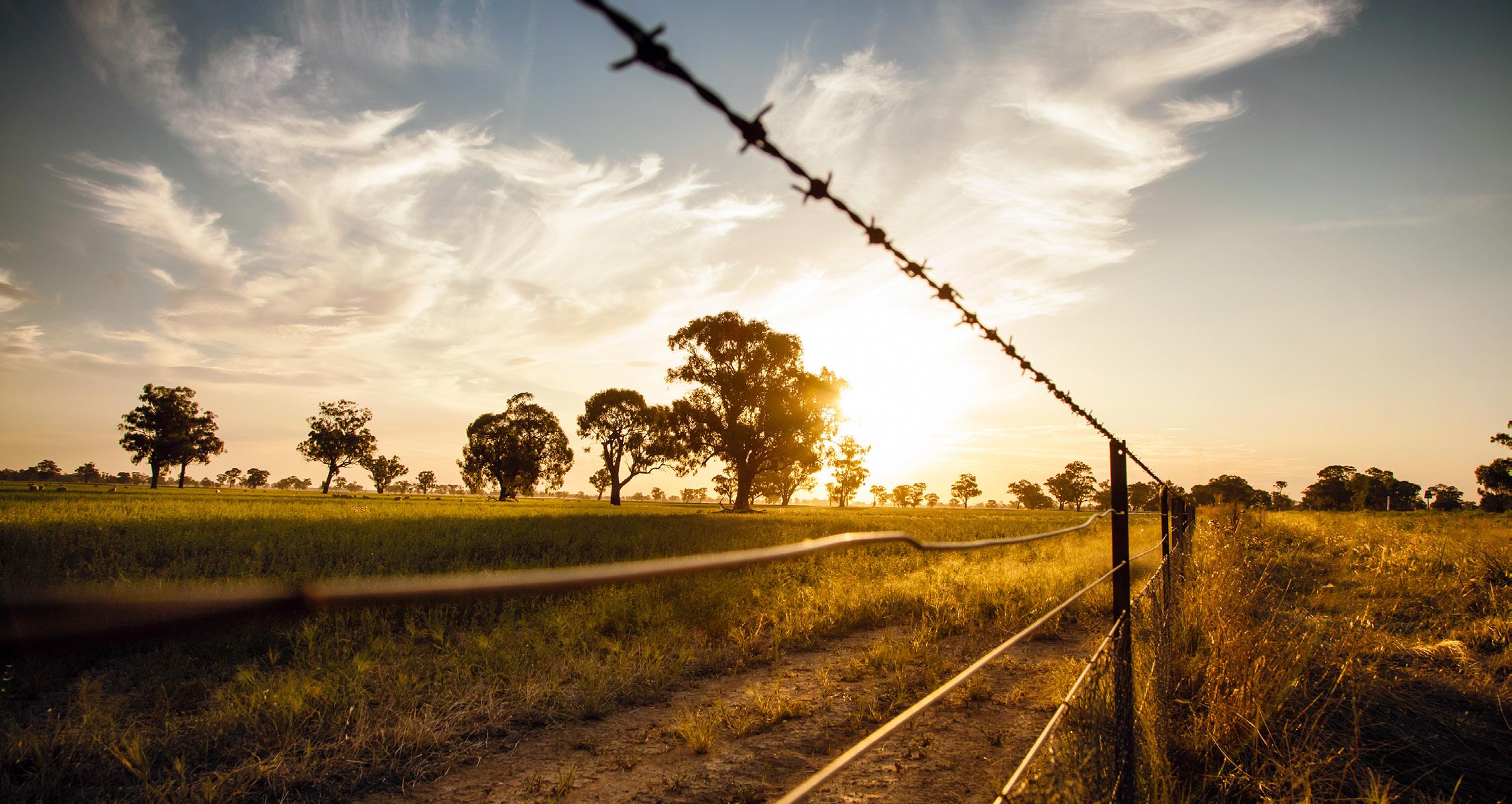
are some of the learnings I have gained along the way in setting up my country practice.
While the distances are greater than in the city, the connections are closer
One of the things that has struck me is how intercon nected everyone seems to be out in the country.
In the city it is much easier to remain somewhat anon ymous in daily life. My encounters with my clients out side of scheduled appointments were very, very rare.
Not so in my current location.
The chance of bumping into a client at the local shopping centre, a medical facility, the pub, a funeral, or a gathering at a friend’s place is so much greater.
Not to mention that there are often fewer degrees of separation between individuals that I work with profes sionally and those I meet elsewhere in the community.
Due to the confidential nature of the work I do, this has meant that I have needed to think carefully about how I might respond to a chance encounter with a client out side of a session.
It has also meant that I have had to draw clear bound aries as to when I am wearing my professional hat and when I am not.
Both these things have required me to think even more carefully about how I present myself and what I choose to say both in and out of the counselling space.
Although this is changing in response to the expe rience of COVID, I have been surprised at how many successful businesses in my area do not have much of an online presence and are not making use of current technology to increase efficiency in business practic es.
This has had an impact on how I raise awareness of my business, and has challenged my assumptions about what is accepted practice.
Educating clients in the use of technology and helping them develop confidence in using it was not something that I expected to be doing!
I have found that taking advantage of opportunities to connect offline and not being afraid to be a little bit more personal than I tended to be in a city-based prac tice has been complementary to my online marketing and has strengthened my local credibility.
Never in my career have I been so aware of the impor tance of intentionally building good relationships and of practising with integrity.
Not that this is a radical departure from practice.
It’s just that in smaller communities, your word really is your bond, and if you don’t follow through on what you say you will, the repercussions can be massive, far-reaching, and even destructive, if not fatal, to your reputation.
This has taught me to be even more careful about what I say I can do and what I will do. Under-promising results and over-delivering on service has assumed an even greater significance in a context where the local grape vine can transmit a bad experi ence around the local community in the blink of an eye.
It has also highlighted for me the importance of trans parency of not just processes but also the reasoning behind the processes in managing expectations and defusing potential conflicts before they begin.
This has meant not just having things in writing but also making time for people to ask questions and make sure they really understand how things work.
Being flexible to explore alternative processes, time frames and responses that can meet both client and business needs is part of the deal.
And being the relative newbie in the community, I am conscious of toeing the line of presenting my expertise without communicating any hint of superiority due to my professional qualification or experiences gained elsewhere.
As I say to all my new clients, the wisdom and richness of our lived experience is valuable.
The longer I am here and the more that I am getting known as a person and a professional, the more trust is being built.
While longevity in the area is helping, I cannot afford to take that trust for granted.
Running a country practice has its unique challenges. Yet it also offers amazing opportunities to be connect ed and involved in a community that would be more difficult to replicate in a metropolitan context.
As I have adapted my practice to the rural context, my business is succeeding in ways that I did not antici pate, and I am enjoying the relational network that is forming around me and my business.
My goal is to be seen as a true-blue, ridgy-didge coun try counsellor who is an active part of the community and a trusted avenue of support for the well-being of all.
One day I might even have the boots to prove it!
Neville Starick is a qualified and experienced counsel ling therapist who has been providing a non-medical approach to mental health for over 14 years, more than half of those in private practice. He offers counselling and reflective practice both face-to-face and online.

Prior to working in the counselling field, Neville worked in various roles within the education, hospitality, and corporate sectors both in Australia and overseas, which have developed a wide range of skills and expe riences that inform his therapy. Since 2020 he has also been supporting other counselling therapists to build and grow successful private practices.
To find out more about the services Neville offers, use this calendar link to schedule a free, confidential 15-minute call: https://go.oncehub.com/ServiceEnqui ries
Neville and his wife have been enjoying the country life across the Murray from Mildura, Victoria since the be ginning of 2018. He enjoys running, gardening, visiting new places, reading good fiction, and having deep con versations over a good coffee.

On October 9th, 2019 life came to a screaming halt. Hubby and I had taken our two teenage girls on a car avanning holiday to Bright in Victoria, 1000 km from home. We had driven up to Falls Creek to check out the melting snow at the end of the snow season and driven back down to a beautiful town called Mount Beauty.
About two minutes after this photo was taken I was a screaming heap on the ground after falling and dislo cating my right knee and left ankle. Three days in hos pital, a tortuous trip home and a slow 4 month recovery caused havoc in my life. However, it also paved the way for a successful online counselling business.
I live in rural South Australia in a small farming community in the Lower Mid-North. We had moved from the Yorke Peninsula in 2014, so that I could work as a school counsellor in one of the local schools. Counsel
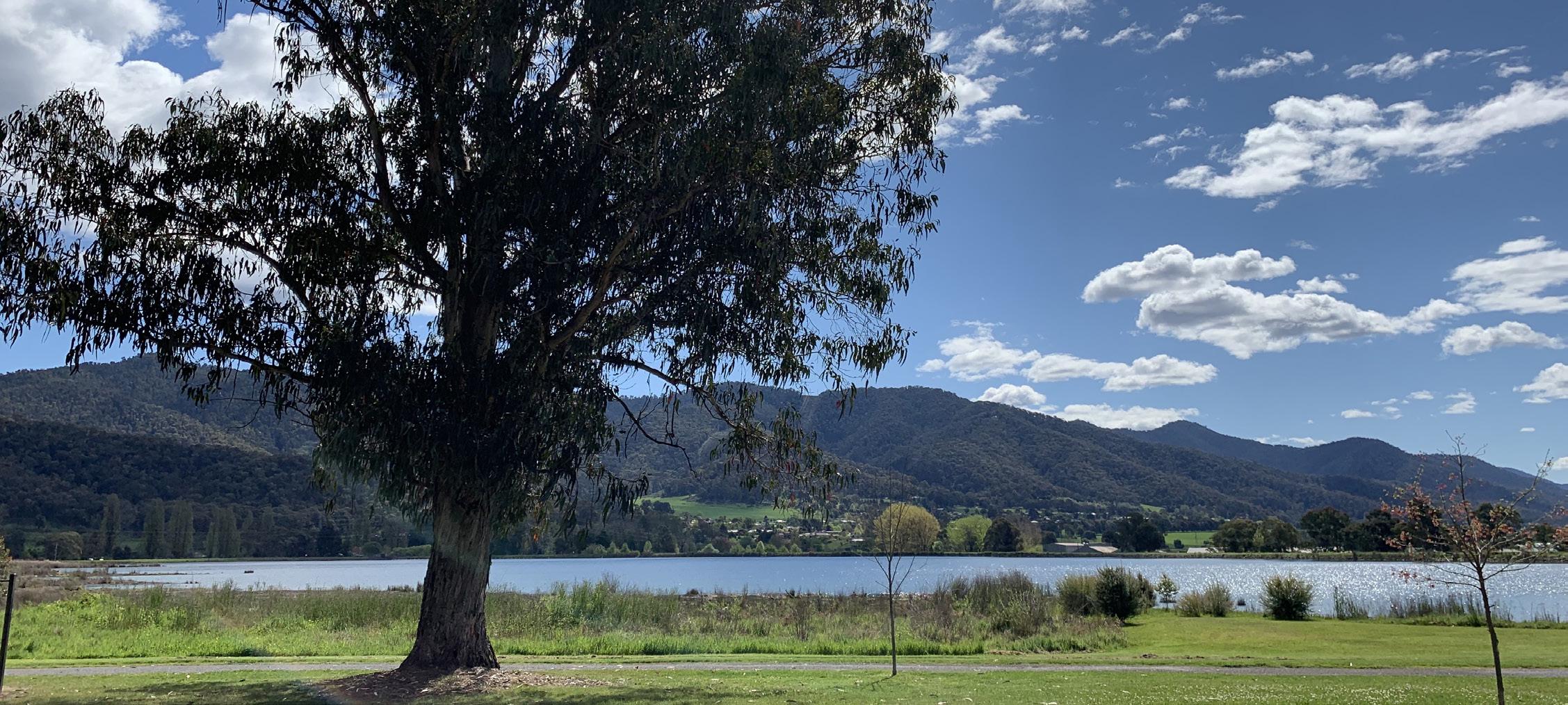
ling is my passion – it was a career change after many years in retail and raising children.
For 6.5 years it was a dream come true working with young people and their families in a school setting. It was immensely rewarding but also a very tough job, one that comes with personal costs due to the nature of working with young people who are at risk.
I was also still raising my own teenagers. My husband at that time was still a fly in, fly out worker. At the end of 2017 I experienced burn-out and decided to take a year off, unsure whether I would return.
At this point, I decided to focus on starting my counselling practice – except I had never run a business before.
I began my working career in the 80’s and came from a family that all worked for people – never for them selves. I knew nothing about running a business – they don’t teach you that in counselling school!
I still needed income in my year off so decided it was the time to get my business going. It was a slow start working one day a week in the Copper Coast.
I turned 50 in January 2019, a pretty big deal for me. I felt things were back on track, I was feeling better in myself, my business was increasing and I was now travelling to 3 towns to provide much needed counsel ling services.
My year off had come to an end and I chose to ignore the persistent gut feeling I had, and returned to the school working fewer days. I should never have re turned, however. We were experiencing some family challenges, things had changed and I was not enjoying the work environment. As a result, I was not a happy camper!
The hopes I had when turning 50 were fading rapidly. Then the accident happened. During recovery I was still counselling, but couldn’t drive for some time so did it all online from home.
At that stage we had both our girls still living with us and with no spare room I set up my office at the end of my bed with a screen behind me, to make it look professional. I would pack it up at the end of each day and rinse and repeat.
Part of my business is supervising other counsellors (supervision is a professional requirement). I am pas sionate about helping other therapists start their busi nesses and careers.
Since 2018, I have learned a lot about running a busi ness. I had invested a lot of time and money learning how to start and grow a successful and enjoyable counselling business.
I was now enjoying passing on my knowledge to oth er counsellors through supervision and training and it was becoming a profitable part of my business.
As we all know COVID turned everything upside down for many people around the world – often in tragic ways.
Working in a school environment where I was not hap py, during the early stages of COVID became unbear able so in May 2020 I resigned. I was also working remotely for an RTO training counsellors and focused on building my business. A big and terrifying step for someone who liked financial security and had always been an employee.
Growing a successful counselling business
I made the decision in the early stages of the COVID pandemic to go online with my business and cease face-to-face services due to the ever-changing rules and uncertainty in health organisations.
It was certainly a game-changer and little did I know at the time, but it would triple my business.
I also organised an online summit for counsellors to help them get online quickly during COVID, so we could continue to assist people who needed support during such difficult times.
At the end of 2020 one daughter went off to uni and we converted a room into a wonderful office for my busi ness. I finally stopped working from the end of my bed!
Going online has allowed me to effectively provide counselling services to a much wider area. I now have clients coming from the Copper Coast,Yorke Penin sula, Mid-North, Clare Valley and Adelaide regions of South Australia.

Through word of mouth I have begun to branch out in terstate with clients in NSW and QLD. The counsellors I work with come from all over Australia and even over seas.
Currently I work with clients and counsellors 3.5 days a week and spend the rest of my working week develop ing and improving my business and looking after me.
I am generally booked ahead by about 2 weeks and my next goal is to increase the capacity of counselling services in rural South Australia by bringing in subcon tractors.
What I have learned along the way Be willing to challenge your own mindset as this will be the number one thing that holds you back. This in cludes your money mindset. ‘People helpers’ often feel they should give away their services or charge less. As counsellors, there are many ways to price services without sending yourself broke!
Be willing to push through the terror barrier. At every stage in the journey of running a business I have had to learn new things. Each of us will have areas that are more challenging and some that come easy. I have been determined to learn tech, websites, social media, advertising and so on.
This can feel overwhelming and I have hit that barrier many times, feeling like it was ‘too hard’. Know when to take a break but then keep going and don’t give up. It is rewarding when you look back and realise how much you have learned and achieved.
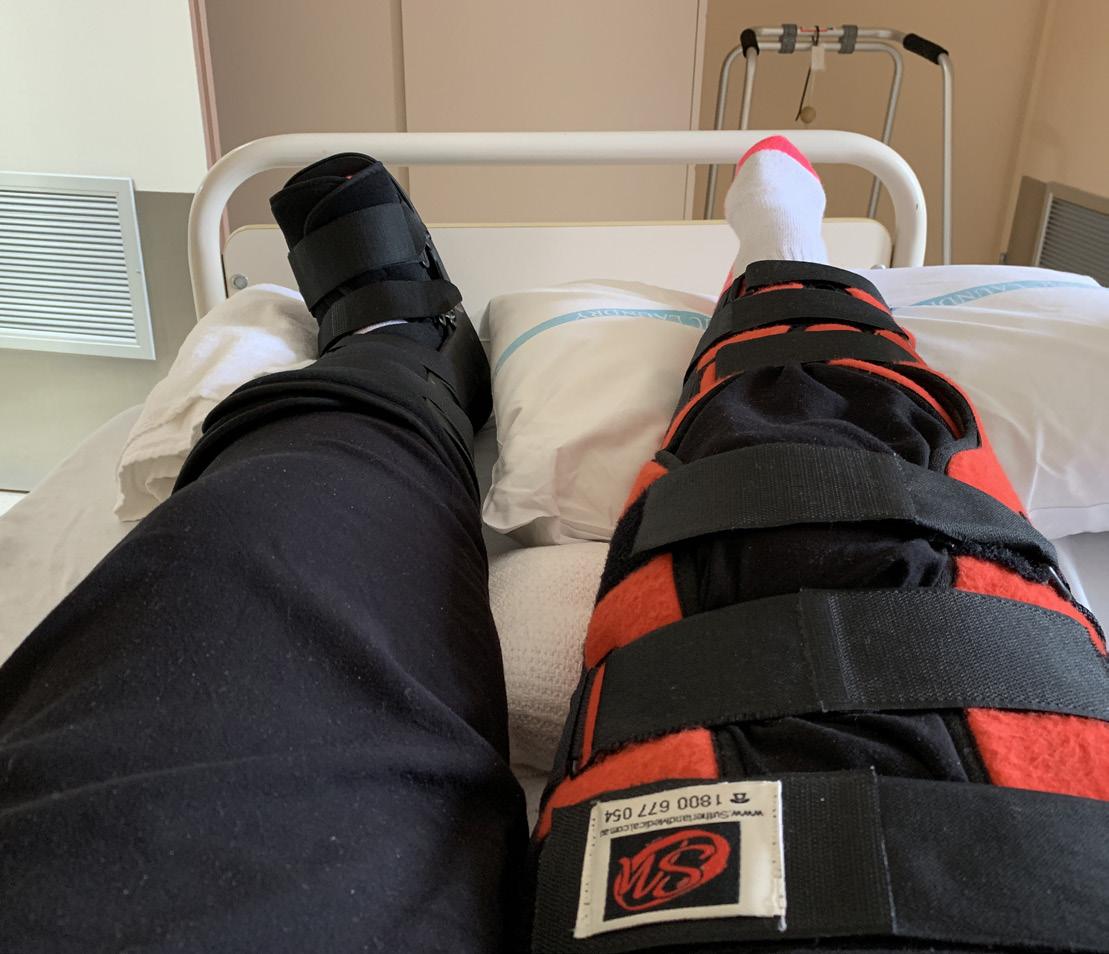
Rome wasn’t built in a day and neither is a business. Go easy on yourself and don’t fall into the comparison trap. Everyone is at a different stage of the journey and we can often wish we were further along it - or doing more, or doing it differently.
Building a business takes effort and commitment. It won’t happen by itself - a considerable investment of time, energy, resources and money is required in vary ing degrees.
Find colleagues, mentors and buddies that understand the journey, can support you along the way and that you can be real and authentic with. Running a counsel ling business is lonely and isolating and you have to be intentional about keeping connections going.
Outsource what is truly not enjoyable or too difficult. I had to learn that I can’t do everything – and I don’t want to! In the early days I had to as I did not have the income to outsource. However, over time you can de cide what you need help with to free up your time to either focus on building your business or have a break. Be smart about it and find people you can trust to give you advice.
Penny Adams is an Aussie counsellor, trainer, business owner who is based in rural South Australia and un derstands the unique needs of regional areas. Penny is passionate about supporting individuals, couples and families to flourish in their relationships, work and life.
Her business, Seasons of Life Counselling, provides professional, accessible and affordable counselling services in rural South Australia and beyond. Her sup portive, compassionate counselling helps you feel heard, valued and motivated to find balance and joy in life.
Penny worked for 7 years in Vocational Education training counsellors and finds joy in supporting many wonderful counsellors Australia wide, through clinical supervision, business support and encouragement.
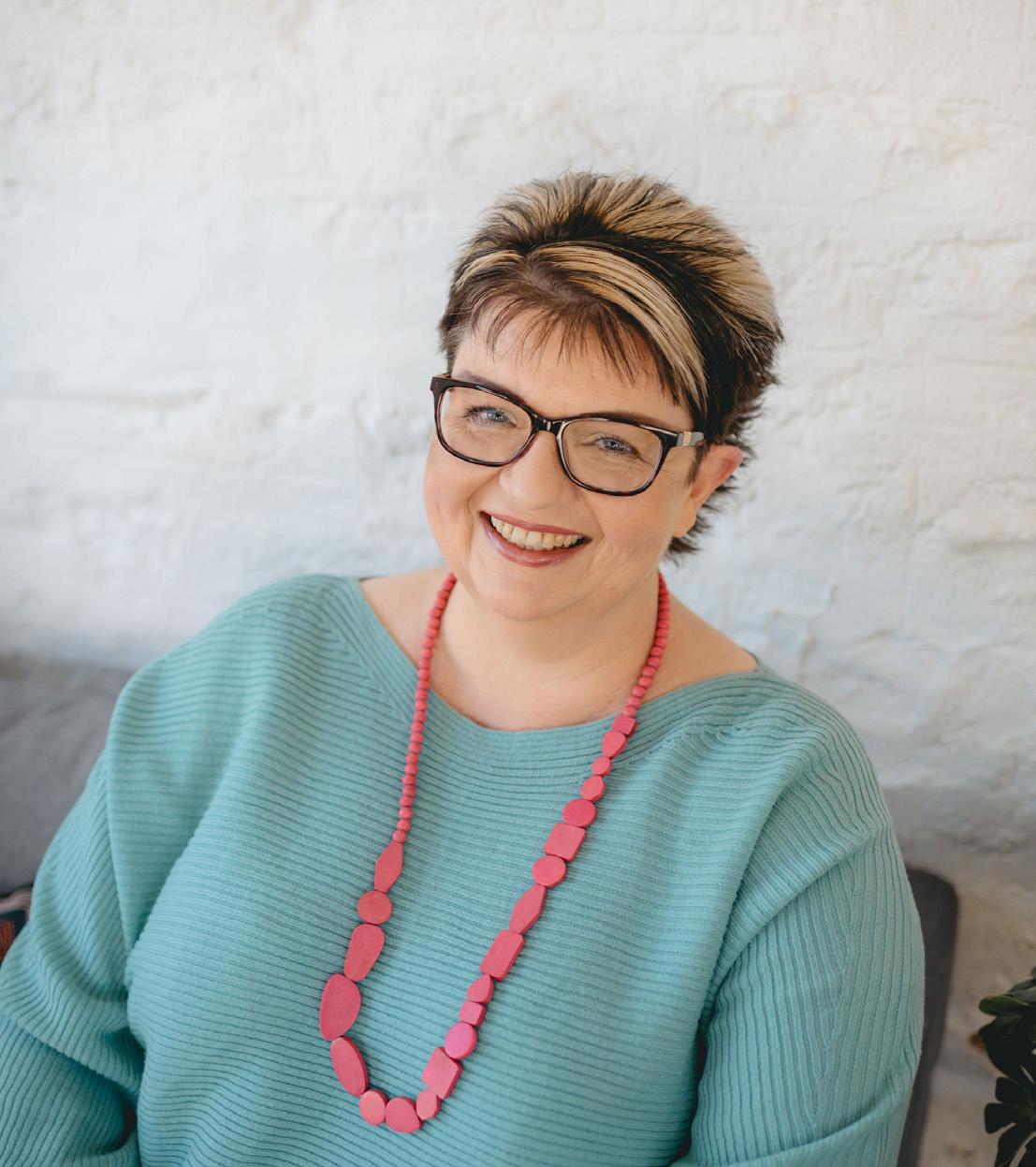
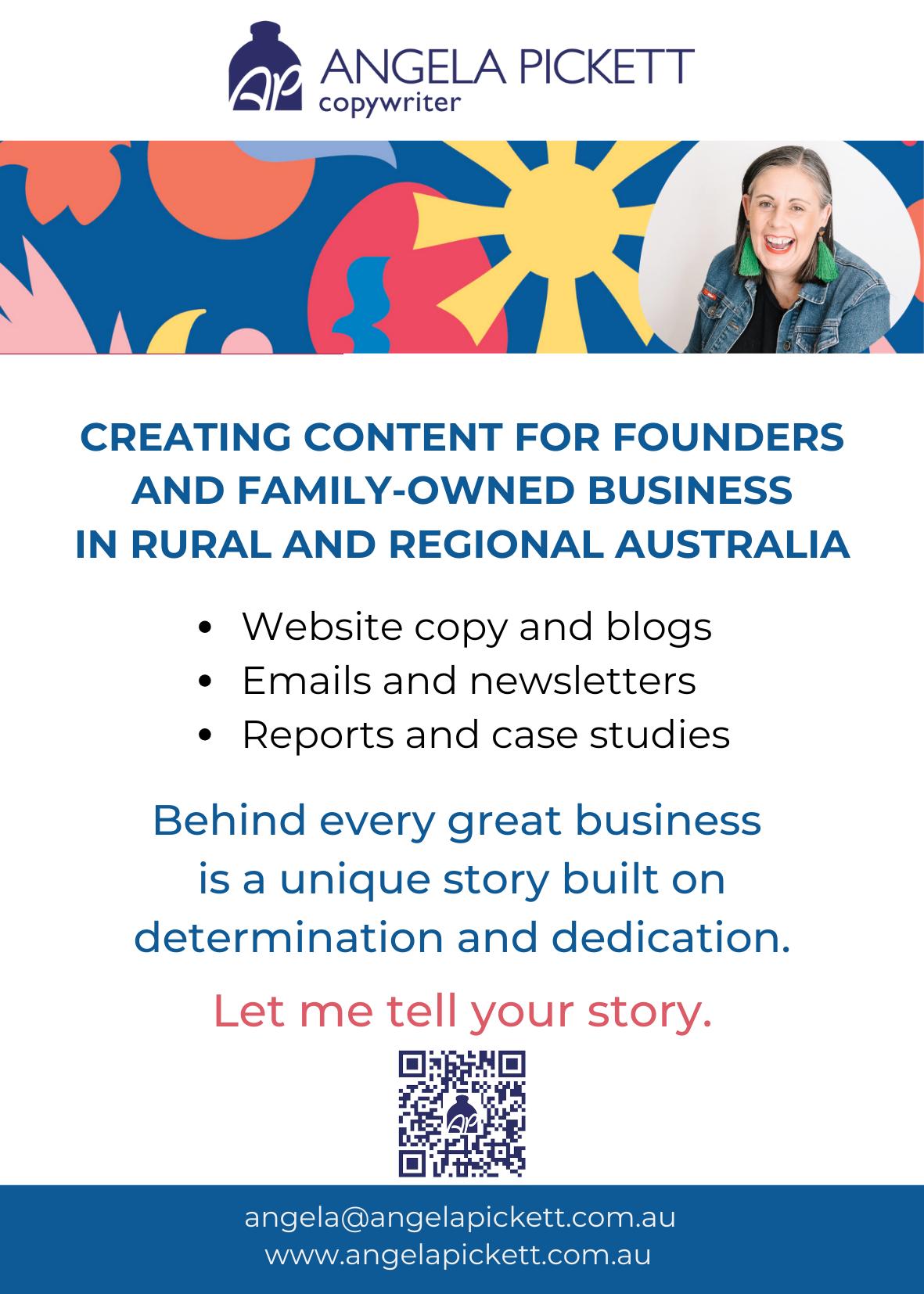
To give pause and cause to induce or entice the user to slow down and indulge in a ritual that represents the essence of what we enjoy as a rural dweller - peace, tranquillity, natural beauty and a more natural rhythm of life. The joy of Ewe Care is the essence of what we have in a rural life; the illusion of simplicity.
Just like some 20 years ago when we left our city jobs to pursue ‘the simple life’ to start one of Australia’s first sheep dairies, we had thought dipping our toes in the water of natural beauty would deliver a unique repre sentation of country life.
Taking our cues directly from the land, our values and our lifestyle and applying them to the loud and busy world of beauty, we would provide a fittingly transpar ent and authentic skin care option.
And it does, but it also represents the fact that us rural dwellers know all too well that we are no less ‘busy’ than our city counterparts. The difference between city and country is that us country folk are artists in the il lusion of ‘the slow life’ but we are masters in selling it. Why? Because if you live it, then it’s as effortless as breathing right (but breathing is actually quite com plex)?
Ewe Care was born to solve problems. Not create them. In fact, our entire parent business, Ewenique Enterprises, has this very value at the core of what we do and it 1000% informs everything we do.
It’s a simple philosophy that aligns nicely with simple rural values. The trouble is the execution of simplicity is by its very nature extremely complex. Just ask any urban dweller and they’ll tell you; the eternal pursuit of simplicity is increasingly elusive, and Ewe Care is no exception to this.
We sought to launch Ewe Care as a thoughtful and con siderate way to solve a problem we had with high val ue excess sheep milk that happens to have significant functionality in topical application.
Ewe Care was launched in July of 2021, mid pandemic, at the same time as our family featured on the ABC’s Moving to the Country. A story that firmly positioned us as a Tasmanian based family business and as innova tors and problem solvers in the space of value adding to sheep milk products.

And we are. That’s why we roll out of bed every morn ing. However, Ewe Care provided a whole new set of problems to solve and innovations to bridge that were well outside of our existing comfort zone of rural food and beverages.
Beauty is a global business of some 622 billion dollars per annum and consumers are extremely knowledgeable and require to be treated as such. Unlike the sec
tion of rural food and beverage consumers to whom we were accustomed, beauty is a super complex land scape full of charlatans and global marketing gurus. It is a highly sophisticated global industry that, feast or famine or global pandemics or supply chain issues, thrives globally with new agendas from green beauty to blue beauty and beyond seemingly popping up daily. It’s a space that moves at lightning pace!
The complexity of Ewe care has come in many forms. Some were already known to us through our other busi nesses such as supply chain issues, freight, packag ing, and the likes, however we were not prepared for intricacies such as specific and peculiar habits around things such as the user experience.
We had considered this in our initial due diligence but had thought that the uniqueness of our packaging and its innovative value proposition would negate this. How wrong we were! Turns out that beauty consumers are not only very discerning about ingredients and sustain ability propositions, but they are also very particular about application techniques and packaging prowess.
This was not just a matter of aesthetics, but more im portantly a function of ritual that we had thought we’d covered off in spades but, in reality, had completely missed the mark!
The dichotomy of the beauty industry is that it openly aspires to so many rural values but by its very nature is quite at odds with them.
As I type this, I am in a car with my mother driving from our farm to a tourism conference in Launceston. There
are irrigation lines in broad acre paddocks lined up in front of pools of water with sheep dotted sporadically in paddocks lining the highway. Life is busy (in a coun try context).
The beauty of the country is that it vexatiously lulls you into a false pretence of things being ‘slow’. I’m not slow. I’m bloody busy! I have two young children. A farm. A cheese business. A distilling business and a skin care business. We have two 7 day a week tourism outlets and 20 staff. I have just come back from an overseas trip where I landed in Sydney on Friday night. By Sat urday morning I had started my first 12 hour day back ‘on the tools’ selling cheese at a cheese show. Flew back Sunday morning for a little family time and will now spend the next two days with my tourism hat on.

But on any given day, when asked by strangers or even in passing observation, I live my life at a natural pace, you know, slow and rural like…
One of the biggest challenges of Ewe Care is the com munication that simplicity is central to its undeniable natural rural link, a proposition which makes the chal lenge strangely more complex.
Aside from the isolation from conventional consump tion of such products (which is both a blessing and a curse) and therefore the ability to observe in real life true consumer habits.
In life we communicate this in several ways. I know if someone is wearing a pair of RM’s and an Akubra that it’s likely they come from the land and are probably not Tasmanian based (the Tasmanian boot is Blundstone). These are intuitive and easy things to measure be

in ‘customer first’ and that the beauty category is far removed from ‘unfussy’. Quite the opposite, it’s very fussy and literal.
The blessing in all of this, irrespective of slow vs fast or city vs country is that even though my rural existence has provided innumerable challenges on my entrepre neurial journey, the most valuable thing an entrepre neur has is the space to think and breathe.
Living in surroundings devoid of artifice is the perfect environment to think, feel and create. This is the big gest asset I have, to overcome challenges.

Ewe Care is Australia’s first ever luxury skincare brand to formulate with Awassi sheep milk.
Pioneering an untapped sector in the category, Ewe Care is making significant traction by educating con sumers on the benefits of waste reduction by repur posing sheep milk not suitable for cheesemaking and turning it into skincare.
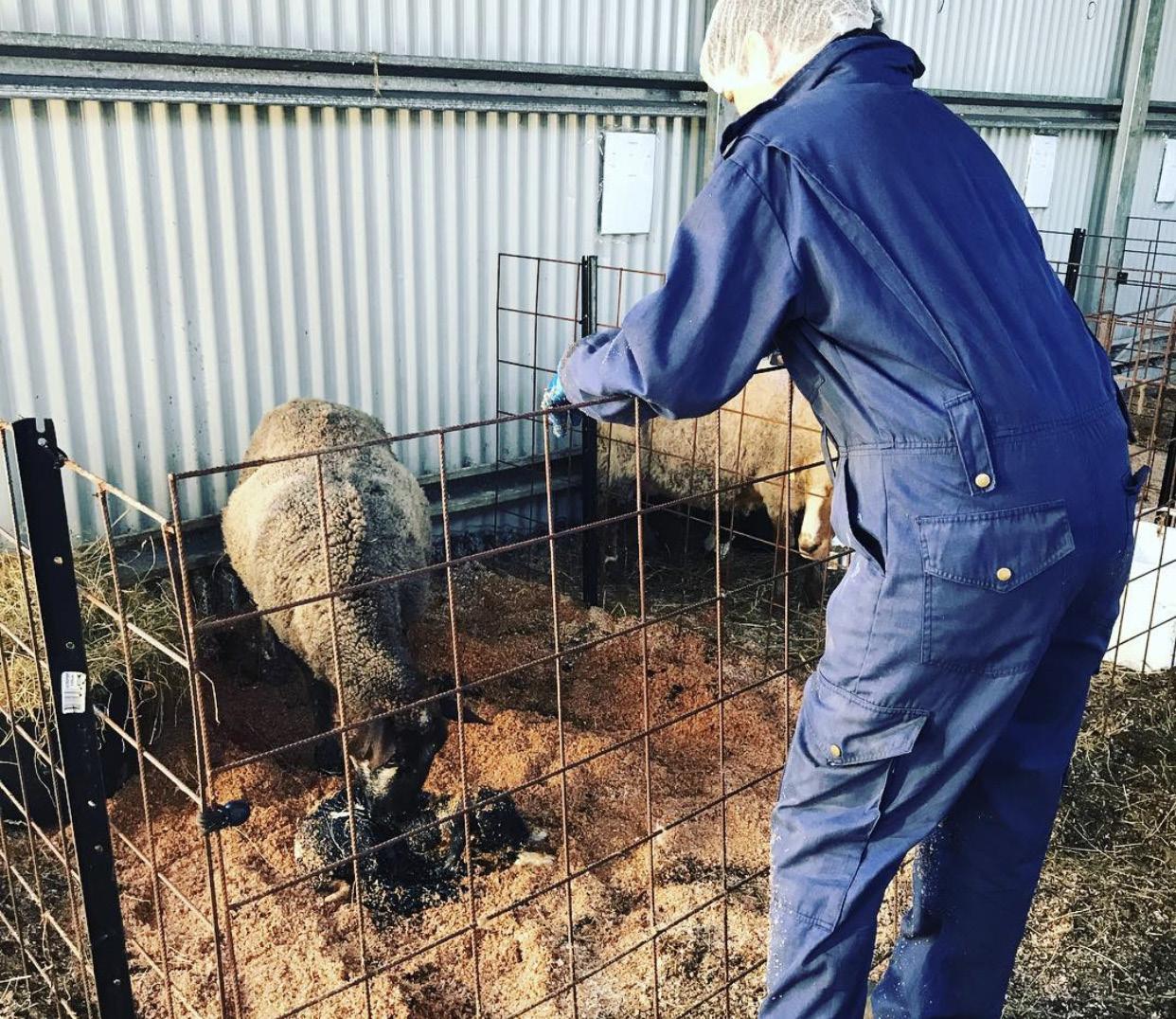
They have also implemented 100% home compostable packaging across their entire range and are leading the narrative on how to be a better sustainable business in 2022.
www.ewecare.com.au
cause I see it every day and I live it every day and these values are my values.
As farmers much of what we do is very intuitive where as in the beauty space almost everything is quite liter al. The biggest challenge as a rural entrepreneur which has been highlighted to me on my Ewe Care journey is that because of distance as much as a personal dispo sition of being ‘unfussy’ – I have had to learn a lesson
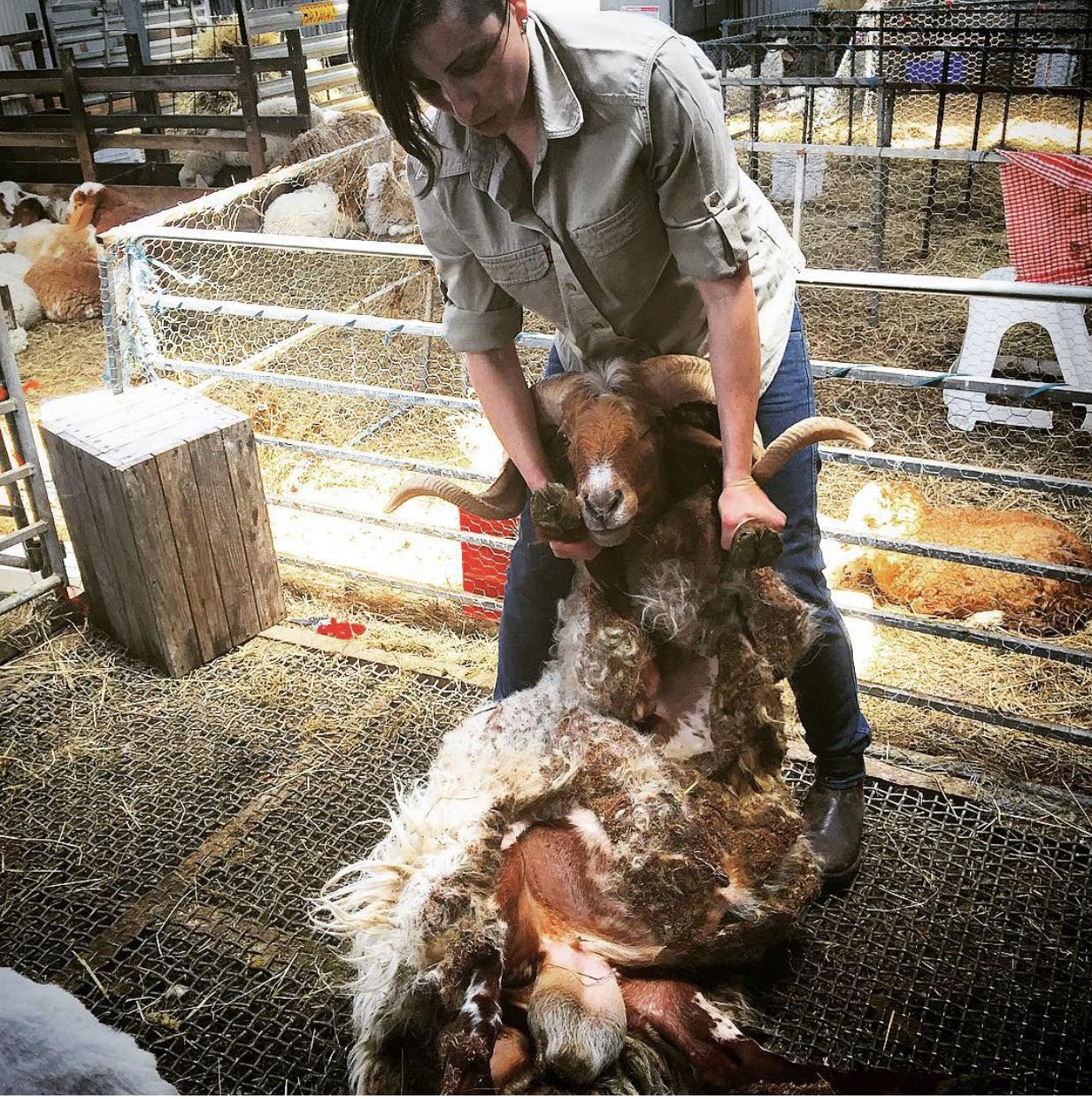

The SEO (Search Engine Optimisation) industry is un fortunately full of cowboys. And not the good type with those sexy hats and tanned muscles. Nope! These SEO cowboys will endeavour to impress and bamboo zle you with a whole heap of technical jargon – then promise to fix all your SEO conundrums while taking a significant quantity of your hard-earned cash – and then utilise a whole heap of spammy, out-dated tactics that garner you next to no results.
Yuck! And drat. Yet, SEO is a very solid marketing strategy that can bring you in a heap more sales (or bookings, whatev er it is you desire!). And it’s definitely worth the effort when done right.
Google now processes over 40,000 search queries ev ery second on average, which translates to over 3.5 bil lion searches per day and 1.2 trillion searches per year worldwide (according to https://www.internetlivestats. com/google-search-statistics/).
Plus, here are a few more interesting statistics that may help you to prioritise SEO as a marketing tactic for your business (from https://inter-growth.co/seo-stats/):
• 68% of online experiences begin with a search engine.
•
• 61% of B2B marketers stated that SEO and organic traffic generate more leads than any other market ing initiative.
•
• 70% of online marketers say that SEO is better than PPC for generating sales.

•
• 63% of all shopping begins online, even if the pur chase itself happens in a store.
Clearly, putting some effort into ranking well on Google is a very good idea.
The question is, how on earth do you become ‘Googla ble’ (aka to appear on Google) and who do you trust to help you?
Well, we have the answers, the low-down and the com plete scoop on the basic fundamentals of real and proper SEO and how you can spot the difference be tween the ‘real deal’ and the ‘cowboys’ so your rural
business doesn’t end up fooled. That way, we can leave the real cowboys, doing what they do best, out in the paddock.
SEO can have two main approaches, depending on the nature of your business, and it’s important to know which one you should be doing.
Local SEO is important for when your business only targets a limited, local audience. Think a bricks and mortar retail store with one location, or trades such as plumbers, who only operate within a certain area.
So, instead of trying to rank for ‘plumber’ you would be better off trying to rank for ‘plumber (your suburb)’. Keep in mind that ranking for ‘plumber Melbourne’ or ‘plumber Sydney’ is going to be a lot harder than rank ing for one or two smaller suburbs, so use that little piece of knowledge to your advantage.
Organic SEO, or non-location-based SEO, is for when you want to target a specific keyword or phrase, re gardless of where a client or customer may be based. If you’re an online retail store, or a service-based busi ness that can service customers across Australia, this is clearly what you will want to do.
Quite often though, it can be harder to target keywords and phrases that don’t involve a location – as the more specific your key phrases are, the easier it is to rank (generally speaking!). To combat that, your best bet when starting out is to target what’s called ‘longer-tail’ keywords/phrases. For example, instead of targeting the highly competitive word “Socks” – you might in stead target “Funky blue socks with fashionable holes” etc.
But we’ll cover that in the Keyword Research section to follow.
Regardless of which you choose, you will want to set your business up with a Google MyBusiness account. Just do a Google search for that. It’s relatively straight forward to set-up (although you will need to wait for a verification postcard potentially) and will ensure Google knows as much as possible about you and what you do – to give you your best chance at ranking. It also helps you to obtain and manage customer re views on Google (important) and allows you keep infor mation such as your trading hours up to date. You can (and should) also post regular content updates to Goo gle (just like you might on your social media profiles).
In order to ‘do your SEO’ properly, your first step should be keyword research. This is the process of determin ing which keywords and phrases you would like your website to be ranking for, as a whole, and for each page. It also helps you to map out your site structure
and page names.
Yes, it is possible to take wild guesses as to what key words you’d like to rank for. Sometimes, in the early stages of your business, you can get away with this a little.
Yet, you’re not likely to get nearly the same results. If you can get a professional to do some basic keyword research for you, please do. It often doesn’t cost much more than a few hundred dollars and it’s certainly worth the effort. Or, if you hire a good SEO website copywriter to write your page content, it’s often included.
This step literally determines how successful your en tire SEO strategy ends up being – so it’s worth getting it right from the start.
The keyword research process basically involves a lit tle research into your business, your industry and your competitors, to come up with some potential keywords and phrases. Then, it’s a matter of using an SEO tool, such as SEMRush or Mangools (that’s what we use!), to determine how easy or difficult it is to rank for those words or phrases, and how much traffic they can po tentially yield.
A good ‘keyword researcher’ will then use these details to make highly educated and realistic recommenda tions as to what you should be targeting – based on the right balance of potential traffic gain and achiev ability.
Note that often, when you’re just starting out, it’s a lot easier to choose longer phrases to target that are more specific, as these tend to be easier to rank for, before going after the harder, more popular (and broader) search terms.
Trying to rank on page one for something broad like ‘furniture’ is going to be pretty near impossible for a tiny business, when up against the major brands who are far more established (and have much higher mar keting budgets).
How you perform keyword research would be an en tire blog post (or book!) in itself, so it’s impossible to go through the process in this article – but the end re sult generally gives you a spreadsheet with suggested page names mapped out for your website and the pri mary and secondary keywords or phrases each page needs to target.
Once you have your keyword research, and your pages all mapped out, it’s time to start writing your content or copy for each page.
This is precisely what I do. Because honestly, it’s soooooo worth doing well. Writing is an art form and writing for both customers AND Google can be pretty tricky.
An SEO Website Copywriting Specialist like me, has years of experience walking the tightrope between customer-friendly and google-friendly content.

• Figure out your customers main pain points – write their pain points down, in their words.
• Repeat their words and pain points right back to them to provide the ‘hook’ – and then lead them down a path, towards your business, as being the solution. (Easy right?)
• Add in your keywords naturally and strategically, throughout your copy and pages, to attract Google.
• Write meta titles and meta descriptions for your pages.
Sit back and watch your rankings climb (maybe!).
There are also other rules you’d need to know, such as making sure you use your primary keyword in the first 100 words, how to structure and word your page titles and subtitles, the best ‘keyword density’ (number of times you use certain keywords) etc.
See, I kinda did tell you it wasn’t as simple as you might think. It seems simple on the surface, but in reality, when you sit down to write this stuff and remember 25 different Google rules at the same time, it just isn’t.
Business owners are also often just too darn close to what they do, to see what they need to see, and then communicate their value clearly to their customers.
Which is why it’s worth the effort hiring a profession al copywriter who can get inside your head, your cus tomers’ heads and write those winning messages that convert AND attract Google’s attention in the right way. (Insider Secret: Even copywriters get other copywriters to write or at least review their own website copy! It’s always easier writing for someone else, than it is to write for yourself!)
And sadly, it’s not as simple as simply throwing a few of your keywords into your copy. It’s also not a good idea to outsource this to cheap overseas suppliers or lower-quality copywriters. Sorry – but it just isn’t! You’ll end up with that nonsensical copy that makes zero sense to anyone, and certainly won’t get you found on Google.
Always, always, write for your customers first. There is no point driving traffic to your site via SEO, if your website copy doesn’t help you convert that traffic into actual buyers.
So, here are steps towards SEO Website Copywriting success:
• Determine the tone you wish to use, that best re flects who you are and attracts the right customers to you.
• Maybe that’s light-hearted, quirky, crazy, laid back etc.
Be aware too, that some copywriters may write web site content without optimising it for Google. So, if you hire someone, make sure you get someone with experi ence in SEO Website Copy, not just ‘website copy’, par ticularly if your goal is to improve your rankings (which it should be!).
This is where we get a little trickier. And this is an area where I am by no means an expert – but we do have ‘techies’ on hand to help clients if needed. There are a whole lot of nitty gritty technical details that contribute to determining how highly you rank on Google.
The main ones include:
• Ensuring you have an SSL certificate correctly in stalled.
• Site load speed – on desktop and mobile (big one!).
• An optimised design and layout – on desktop and mobile (mobile is critical as apparently everyone searches for things on their phone!).
• Metadata on images.
• Correctly named (and optimised) images and files.
• Meta data (title and descriptions) for each page on your website (this stuff is hidden in your website and only read by Google).
• Not having duplicate meta data (using the same meta title or description on multiple pages).
• Ensuring you have an XML sitemap
And sooooooooooooooooooooo many more things. But unless you know the things, and fix the things, you just won’t get your rankings where you’d like them. There are many great online tools that can help au dit your site automatically and show you where your issues are. Something like SEMRush or Moz etc. But these services can be expensive – and if you’re not a web developer, while knowing where your issues are is great, it’s also pretty useless if you don’t know what to do to fix them.
Keep in mind that different website platforms handle SEO technicalities differently as well. WordPress is by far the best and most flexible platform out there to use to build your website, but it can also require the most technical skill. When using WordPress, make sure you use an SEO plugin, such as Yoast, as this will also help guide your content on each page. It’s not perfect, but it’s useful.
Other platforms, particularly eCommerce platforms, such as Shopify and BigCommerce often have fields on each page and product which allow you to fill in your metadata. Please do this, as best you can. Make them useful, enticing and include your keyword.
Later, if you get help from an agency, consultant or copywriter – you can improve these.
But there are still other nitty gritty coding issues that you may not see when you edit your pages in your ed iting software. So that my friend, is where you need a web developer, who can fix these technical elements for you.
(Even I need to defer some technicalities to the techni cal pro’s.)
Next, we have the good old content marketing game to play. This is where you continuously update your web site with new and interesting content, so Google keeps noticing you, and you build your reputation (and traffic) with them over time.
Generally, this happens in the form of your blog. Which also serves a dual purpose of nurturing your audience too.
Now, there is good content marketing and there is bad content marketing.
But again, you need to make sure you’re creating con tent for your intended audience FIRST, and Google sec
ond.
Partly, because content marketing and SEO can be a little hit and miss, with no real set formula.
And if you’re just starting out with creating your blog, and writing content, you’ll want to keep things pretty simple to start with.
Aim to publish a blog post each week if you can. Oth erwise, just try to keep it as consistent and as regular as possible – if you’re only going to post once a month or once a fortnight, try to do it at the same time, each month or fortnight.
Having some consistency for your customers helps them, and it does help Google too, as the algorithms will pick up the patterns over time.
When first starting out, focus on writing about topics that you know about and that you think will interest your customers the most. That way, your customers will actually bother to read them, and hopefully (even tually) will encourage them to buy something or work with you.
Don’t worry too much about length to start with – but ideally, try to aim for 600 – 800 words as a bare mini mum.
Once you’re able to do this on a consistent and fairly often basis, you can start researching and targeting topics specifically to assist your SEO rankings. And in fuse your blog posts with keywords to try to get Goo gle’s attention.
When writing a blog post that you want to rank well for, you will most likely need to aim for a minimum of 2000 words. It’s been well researched and established that ‘long-form’ articles and pieces of content attract more attention from Google, but also, amazingly, get more attention from your audience on social media too.
But again, you need to keep it customer-friendly and useful, and not just pump out silly, useless content stuffed with keywords.
In order to come up with appropriate topic ideas, you might enjoy visiting Answer The Public (https://an swerthepublic.com/). It allows you to type in any word, any phrase, and it will give you a whole tonne of sug gested popular searches.
Because once you know what people are searching for (in their exact words!) you can then create a blog post around that topic, with that precise title.
And of course, once you do go to the effort of writing and publishing each new blog post on your website –you need to make sure you’re driving as much traffic to it as possible, by sharing it across your social media pages.
Not only does this help towards your SEO but clearly, the main purpose is to help your audience and hope fully nurture them over time, so you convert a few into buyers. Two birds, one stone and all.
Last, but not least, you need backlinks. A backlink is simply a link from another site to your site. Generally speaking, the more backlinks the better, providing they are quality.
But not all ‘backlinks’ are equal. No, they are not. The tactic a lot of people use is to simply plaster your link on every crappy directory website, known to man. You know the websites – the silly ones, which claim to be amazing and useful listings of websites, when really, they just dump a whole heap of categories and a whole heap of websites underneath, and that’s about it. Trouble is, these websites don’t get a lot of respect from Google.
Such tactics used to work in the early days of Google, but Google keeps getting smarter. They know what you’re doing when you do this. And if you have too many ‘spammy’ type directories pointing to your web site (particularly if they have a low domain authority etc.) – then it’s really not going to help your rankings at all.
The best and only real way of creating QUALITY back links, is to do a search for some relevant and useful high-traffic websites either in your industry or within complementary industries and ask them nicely for a backlink.
Most important and popular websites though, won’t just chuck up a link to your site, for nothing.
You may need to pay for some advertising space.
Or you may need to write a guest blog post (better any way) and attempt to get them to publish it for you. Generally, you need to create strategic alliances with
other, high-traffic, well-performing websites – or give them something in exchange for the link.
And if you have an industry association – sign up for their membership. This gives you both credibility and most will promote members and provide a backlink.
I’m a firm believer that the more educated you are, around a certain topic, the harder it is for anyone to pull the wool over your eyes!
Which is why, this post has been jam-packed with REAL information about SEO Best Practice, so you clearly know what’s involved on both a once-off and an ongo ing basis.
This will help you to determine whether an agency is trying to ‘fluff you’ with sales and technical jargon – or if they genuinely know what they are doing.
SEO is a long game. It’s not a quick fix. No matter what anyone tells you.
It’s also not as simple as adding a few keywords to your headings and content on your website. And it’s gener ally not a one-size-fits-all scenario. Your business and your website should be treated as individuals with an individual strategy.
A successful SEO strategy requires a solid understand ing of the topic and industry, a very clear plan of attack, solid keyword research and solid performance tracking to ensure your site is headed in the right direction. A good strategy will not simply involve adding you to a gazillion directory websites – as this will do more harm than good.
It is far too easy to be fooled. In our previous eCommerce/retail business – we were fooled by an agency, simply because we didn’t know any better. Even with my marketing and website expe rience and my knowledge around SEO Copywriting – I fell for all the technical jargon that I did not understand. That’s why, I went on a journey to learn EVERYTHING there is to know about SEO and why I was so compelled to share these learnings with you.
I don’t want to see any rural or regional business end up in hot water, because they’ve been ripped off by an unscrupulous ‘SEO cowboy’.
Cowboys in the SEO world are best avoided – the real cowboys are best left in the paddock – and you need a trustworthy SEO agency to help market your business.
If you’re a little bit lost with your rural marketing, get in touch.
We can help you map out a plan to get you where you want to go. Customised to you. Following a proven plan of attack.
We have a strict no bull-dust policy at The Rural Mar keting Company to ensure you get real results for your rural or regional business.

Individually, Toby & Sarah are both incredibly driven and offer very different backgrounds and experience. Together – with their combined knowledge and exper tise – they’re unstoppable.
Sarah is a multi-award-winning copywriter and market er with over 18 years experience. She holds a Bachelor of Technology and is recognised as a CPM (Certified Practising Marketer) with the Australian Marketing In stitute. Sarah is also a best selling author of multiple books.
Toby is an experienced business founder, with multi ple businesses and accolades under his belt. His cur rent business, Billing Metals & Manufacturing, supplies

specialty metals and element samples to schools, uni versities and amateur scientists.
They love nothing more than combining their skills to empower like-minded rural business owners to suc ceed and prosper online.

 By Jenn Donovan – Co-founder of Spend with Us
By Jenn Donovan – Co-founder of Spend with Us
The next big thing for e-commerce is coming soon to Australia, according to the trends from Asia and other overseas countries.
Those already online with a mobile-friendly website and the goal of building a community via social me dia platforms (as opposed to just being interested in followers and likes) are well placed for the next e-com merce wave.
But those who, despite the pandemic, are still yet to get online, build communities and embrace the online space will again find themselves in a “hard to compete” position.
Furthermore, those in small to medium businesses who can innovate quickly will have it over the “big end” of town as this trend gains popularity among business es and consumers alike.
So, what is the next big thing coming for e-commerce?
Selling whilst live on a social media platform. Yet an other trend fuelled by the e-commerce boom arising from the global pandemic.
Recently launched in select markets such as Australia and New Zealand, TikTok live event is a new tool that lets creators schedule, manage and promote LIVE vid eos.
TikTok is fast becoming a platform of choice over Facebook and Instagram for creators. For many, hav ing the ability to go live and sell live via this platform is opening up a new sales strategy for many retailers already on the platform.
Although live selling isn’t new, in fact, I’d say MLM busi nesses probably use Facebook groups for live selling (social commerce), the best of many I’ve seen. But watching lives and taking action with their credit card (aka buying products they are watching in real-time) is a new consumer behaviour that will soon sweep through Australia, no doubt embraced firstly by our Gen Zs and Millennials (the first adopters of all things new!).
Social Commerce has exploded for Asian businesses operating in the e-commerce space. They are quickly picking up on the potential of social commerce to en gage with consumers at the heart of their online expe rience in the realm of social media.
At its core, the strategy gives brands a presence right where their consumers spend many of their hours on line – and it now occupies an estimated 44 per cent of the $109 billion Asian e-commerce market.
With Australian e-commerce businesses heading into their busiest season – Christmas and Summer – build ing an innovative strategy around social commerce will put you ahead of the game and help you stand out from your competitors.
Firstly, and most obviously, have a mobile-ready e-com merce space to send your hot customers who want to buy!
If you don’t have an e-commerce space with secure checkout, this is priority number 1.
Consider marketplace platforms such as www.spend withus.com.au, especially if you’re a small rural or re gional business, which helps you get your products on line, gives you a secure checkout for customers, free marketing and a community of like minded people to help you grow, as well as an online community, reach ing almost ½ a million a month, to get your products in front of. They will be embracing social commerce
Otherwise, platforms like Shopify and Square offer fast solutions for getting your products online, so you can begin embracing this new wave of social commerce. Once your products are online, the second step is to change your thinking from more followers and likes to thinking community and community building.
Business is now all about community. Building a com munity of consumers who know, like and trust you. A community of buyers and a community of buyers who will refer you to their friends and family because they, as above, know, like and trust you.
Communities need leaders – so the best tip for how to build a community – show up and be a leader in your space.
The space of social commerce is a very exciting one for e-commerce businesses and consumers alike here in Australia. And if it is embraced here, a third as much as it has been in Asian countries, it will be the way most of us do our Christmas shopping for 2022.
Jenn lives on a farm in the Riverina of NSW, with her husband and 3 children. Jenn runs a social media and marketing business from her home office (Social Me dia & Marketing Australia) and supports small busi ness owners by helping them get the most from their marketing.
Spend With Us is an online shopping marketplace and directory for rural and regional small business es of Australia who have been impacted by bushfire, drought, and coronavirus. Spend With Us supports ru ral businesses that find it hard to compete due to loca tion, size, technology, and other adversities.
www.spendwithus.com.au

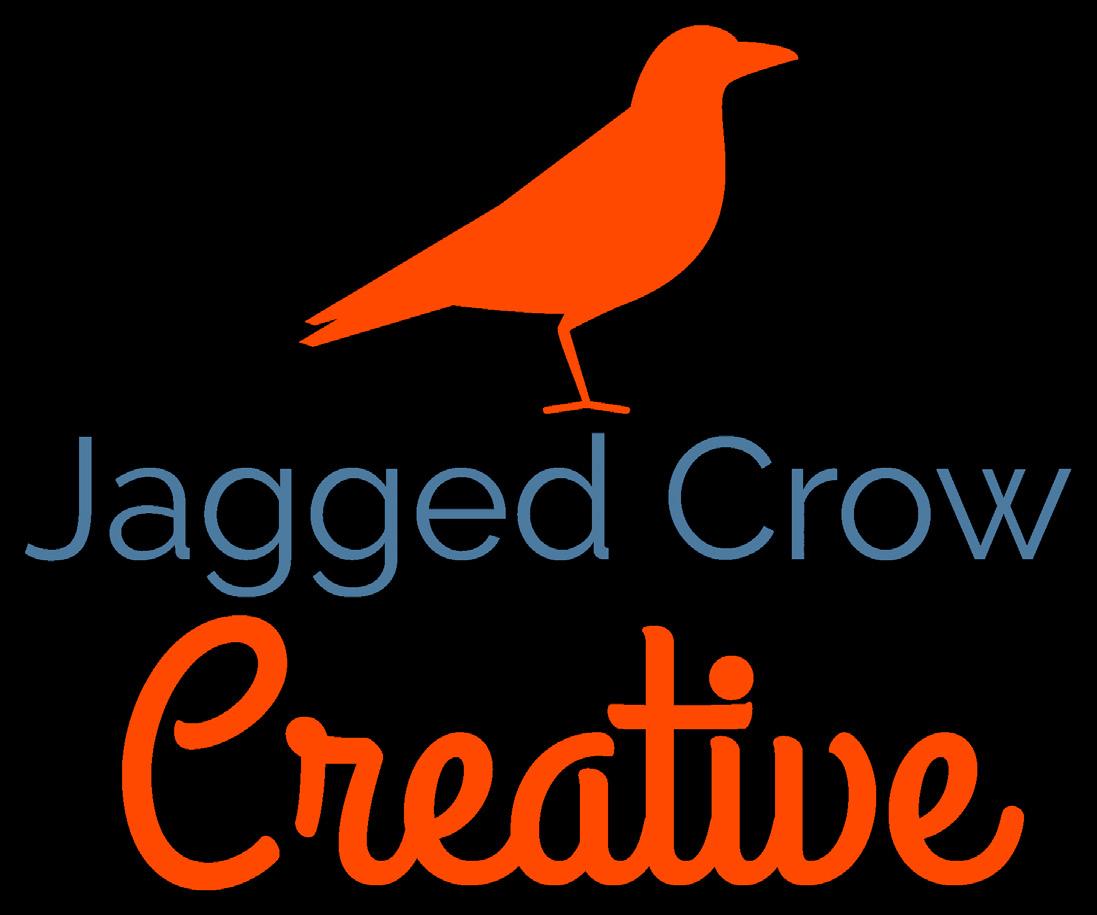
make the investment in building your own digital as sets, such as a website and mailing list, to ensure that you can always contact your target customers. You’ll have a reliable way of letting them know when produce will be available and be able to promote your farm prac tices in an easy and accessible way.
A website for your farm business can giveyou many benefits:
An online store
• If you are keen to sell your produce directly to con sumers then an online store is a must. Having a system which can take and process orders for you while you’re out in the paddock or down in the yards means more people have easier access to purchase your products. And they can order 24/7, when it’s convenient for them, not just when you’re in range and can answer the phone.
Running a farm is a life-changing decision. Likewise, how you market your produce and outputs can be an equally life-changing choice.
It may also depend on the nature of your business. Selling direct to the yards or direct to a distributor can be an easy way to sell your outputs. However, we also know that you won’t achieve your best price that way. There are benefits – you let someone else do the leg work of marketing, on-selling and distributing your product. You may not need to think about packaging or distribution channels.
However, if you are considering direct-to-consumer sales, via farm gate, farmers’ markets, CSA, direct or dering or agri-tourism then it is worth thinking about how you will market your business.
Social media can only get you so far. Not only do you not own the real estate of a social media page, the landlord (or platform) can repossess all your content and contacts without notice.
You are always going to be better positioned when you
• Once people have purchased from you once, you can continue to market to them via an email list. An existing customer is easier to keep than gaining new customers so it is worth nurturing your exist ing customers with stories about your farm, your farming methods and general information about your products.
There are lots of ways to nurture your audience once you have a website:
• Recipe Clubs
• Loyalty Discounts
• Repeat Business Offers
• Share it with a friend reward
• Having your contact details on a website can make it easy for people to find you, send questions about your product, delivery cycles and delivery range. It also means they can send you an email when it is convenient for them and you can respond when it is convenient for you.
•
•
If you are running a farm-gate you probably don’t want people turning up at any time to purchase your products – you can easily advertise your opening hours on your website and have them visit when the farm gate shop is actually open, instead of turning up and finding you not there.
• A website is a great way to advertise your business. Put your business name on the back of your car, on the door of your ute, your business cards, the bot tom of your email signature and people will know where to find you when they go looking.
• A website for your farm offers the ability to pro mote your brand, show off your product offerings and share happy customer testimonials and sto ries.
• It can also be used as the basis for your social media posts and reels. Creating content once that can be used multiple times is just a smart way to use that content. The last thing you want is to be chained to the desk in front of the computer.
• Having a website with fresh content is a smart way to keep Google coming back as well as your social media followers informed about what you have to offer.
Even if you are a regular farmers’ market stall holder or your farm-gate is open every weekend, there will still be days when you don’t sell out, when you take more prod uct home than you would like and scratch your head wondering why people didn’t buy today.
The drive to the farmers’ market can be cold and lone ly. Having a freezer or cold room full of produce that you haven’t moved is frustrating – especially when you know how good it is.
Or perhaps you don’t produce enough to be able to supply customers every week or your produce is more seasonal than that and you want to be able to sell only when it’s available.
Perhaps you want to test out your product on a small group of customers first before launching to the world. Having multiple channels through which to sell your products can be helpful and a website is simply an other channel that works for you while you’re off doing something more interesting.
An effective website that allows you to communicate with your customers, promote your produce whether it is weekly or seasonally and allows customers to or der at a time that suits them, makes sense when you’re busy.
Whether you already have direct to consumer sales, a farm gate, a regular stall at the local farmers’ markets,
a CSA program, direct ordering or agri-tourism. If you are just starting to think about going in that direction, then it is worth considering how you will market your business and seriously consider how a website can be a key part of that strategy.
Finding a web designer that understands farming and rural industries can be challenging. However, it’s worth looking for someone who can understand the limita tions, constraints and challenges that farmers face. It will make communication much easier and the results much better.
If you are considering a new outlet or direct distribution channel, selling your farm’s story through a website is something well worth considering and working to wards. It’s as important as it is to get the branding and packaging right for your produce. Both aspects done well will help you stand out from your competitors.
About Helen Sampson & Jagged Crow Creative
Helen Sampson is a web designer with a corporate background and a small farm who works with people all around Australia who are doing business differently, breaking the chains of the past.
Rurally based on South Australia’s Fleurieu Peninsula Helen has helped small business owners build a bet ter online presence from New York City to rural Tas mania and everywhere in-between. Some of her clients include BnB owner/operators, farmers’ market stall holders, environmental scientists, beekeepers, health and wellness practitioners, vets, not-for-profits and business consultants.
Jagged Crow Creative is her web design, email market ing and blogging business which helps businesses cre ate unique customer experiences for those they serve, and for those who don’t have the time or interest to build their own online presence.
Jagged Crow Creative helps small-medium business owners connect with their ideal customers and build brand loyalty using systems and tools designed to en able them to share their passion and products. So they can do what they love most without adding to the to-do list.
If tech is not your thing and you’d rather spend your time making a difference to the world around you with your unique talents and gifts then talk to Helen – yes she will talk to you – no bots, no auto replies – a real human on the other end.
 By Angela Pickett – Angela Pickett Copywriter
By Angela Pickett – Angela Pickett Copywriter
If the mere sound of the word ‘networking’ gives you hives, I’m fairly sure you’re not alone.
For many solo and small business owners, especially those of us working remotely, one attraction of working for ourselves is being alone. Staying home, working in your Uggs and Oodie, connecting via Zoom or social media.
Now that the world is starting to re-open however, you’re probably receiving invites for actual in-person events.
I actually like meeting new people. Sure, I get nervous walking into a room of strangers. But 15 years of doing it in my diplomatic life gave me lots of practice.
Since moving to the Barossa 8 years ago, I’ve had to get comfortable walking into rooms where I don’t know a soul. This can be hard in a small town where it seems like everyone is related or went to school together.
Even though I still get nervous and still think of myself
as being shy, these days I’m more likely to go up and chat to a stranger.
I know that if I don’t, I’ll kick myself later.
So, I had a think about the things that have helped me survive, and even enjoy, recent business networking events.
1. Pick events that interest you
This might sound obvious, but don’t go to events just because you think you should. Check out events your friends have been to.
1. Do they look like your people?
2. Does the timing and location suit you?
3. Is the speaker someone you want to listen to?
2. Find a friend or take a posse
This might not sound like super professional advice, but who cares? Hopefully, you’ve got a business buddy or two you can attend events with. If not, don’t lose hope. Pick events where you can network in advance or where you’re fairly sure there will be people like you. Don’t be afraid to let the organisers know you’re coming
solo. I registered for an event when I first arrived in the Barossa. The organiser didn’t recognise my name, so she reached out to set up a coffee date so I could meet people before the event. I made a few new friends, and the conversation convinced me to start a blog, which ultimately led to my copywriting career.
Networking has a bad name because there are events where people are just focused on sales. Let’s all agree to avoid those events with a barge pole.
Treat networking events as opportunities to meet people like you, even if they are your competitors. Make friends. You don’t even need to hand out a busi ness card (although it does help them to remember you later!).
Just head along with an open mind.
Being able to confidently say what you do can make all the difference.
Develop a 30-second elevator pitch or introduction and practice it over and over. That way, when someone asks you what you do, even if you’re nervous, you don’t need to think.
For most of my diplomatic life, I wore very corporate suits. As I got older, I decided I could be a bit more adventurous. I was working in Hanoi, which was hot and steamy, and discovered an amazingly creative and colourful brand called Chula.
These days in the Barossa I make a lot of my own clothes. Having bright, colourful clothes (with pockets) can be a networking tactic. People will come and com ment, and it’s an icebreaker.
But that’s one option. Perhaps you have a uniform, or simply a favourite shirt and jeans. Whatever it is, just focus on feeling good.
This suggestion might make you nervous, but if there’s an opportunity to ask a question, do it.
You’ll have the chance to introduce yourself to the speaker and the audience. So even if you don’t feel confident going up to other people, there might be someone who wants to find you and chat afterwards. 7. Use social media to connect with others
These days, lots of events have an option to connect via social media in advance. Make the most of it.
In May, I went to an event called The Huddle in Orange. There was a Facebook group for people attending. It
was a great way for people to introduce themselves and for the organisers to update information.
Once we got to Orange, the event hashtag was a great way to connect with other attendees.
Don’t worry about impressing people, or making a sale. Focus on hanging out with good people, enjoying a good meal or a glass of wine and learning from the speaker.
Building solid business connections is all about play ing the long game.
Networking isn’t about – and shouldn’t be about – how many business cards you collect or hand out. You shouldn’t need to sign-up to regular meetings or meet arbitrary targets about the number of follow-up calls you’re going to make.
And networking isn’t just about meeting business pros pects.
Networking can simply be:
• having a safe space to vent or ask questions
• meeting people facing the same challenges
• finding someone you trust to refer work to
• debriefing on a difficult client
• exchanging stories about the challenges of juggling a business with being a good parent or partner
• making friends you can laugh and relax with.
• Hopefully, armed with these tips and suggestions, you’re ready to attend (and enjoy) your next face to face networking event.
Angela Pickett is a Barossa based copywriter. She’s the creator of powerful words and chief cheerleader for fe male founders and family-owned businesses in rural and regional Australia. Angela writes website content, blogs, marketing materials, emails and reports.
She’s an active member of the local community as the secretary for the Barossa Community Foundation and on the committee of her sons’ hockey club. When she’s not on the sidelines at sport or managing their home renovation, Angela enjoys reading, cooking, CrossFit and trying new wines.
It’s also a business asset. A bit like an employee –it should be producing and contributing to your business, not sitting around doing nothing.
There are 4 key things your website should do for your business:
1. Get your business found
2. Engage your visitors
3. Convert your visitors
4. Make your life easier
Let’s look at these 4 key activities
This means that people need to be able to find your business. One of the most common ways people look for a business is by searching the internet.
If someone is looking for your type of business, or a product or service that you offer, you want them to be able to find you.
And if your website isn’t ranking on Google and other search engines – that is, not showing up in relevant search results, then it’s not doing its job.
In Part 1 of this series on Building Smart Digital Foun dations for your Business, we looked at branding and how it’s often the first impression people will have of your business (you can find the article in Issue 1 of Ru ral Entrepreneur Australia).

Today we’re going to look at websites. Because if you’re a service-based business in rural or regional Australia looking to expand your reach, your website is the cen tral and most important tool for achieving that.
Your website is a big deal. It’s your online representa tion of your business – it’s the place where your ideal customer will “visit” you.
Once someone finds your business website, you want to engage them – in other words, you want them to stay on your website to read or watch your material, click on links, and find out more about your business. There’s not much point to getting a lot of traffic to your website if none of those visitors stick around long enough to read what you have to offer.
Once your visitors find your site and are consuming your content, the next step is converting them. This simply means getting them to take action.
These actions can be:
• signing up to your mailing list
• downloading a freebie (which also puts them on your mailing list)
• contacting you
• booking an appointment
• buying a product or service.
A “conversion” means you now have the means to make contact with them. They are no longer a name less window shopper, but a lead or a customer.
Naturally, a stack of visitors to your website aren’t much good if they aren’t converting.
This is often overlooked when it comes to websites. But it’s a key component to running your business ef ficiently.
Your website should improve your business processes by providing certain automations.
Here are just a handful of tasks your website could be doing:

• sending online sales information to your account ing system.
• collecting leads straight into your CRM.
• online forms that send you data in a PDF format –filing done!
• taking automatic subscription payments.
• enabling people to have instant access to digital content they’ve purchased from you.
Additionally, your website should make life easier for your visitors. When you do, it will increase the chances of visitors taking action on your site and becoming a lead or a customer.
How to get a website that will serve your business well
There are two major aspects that go into developing a website.
The stuff you see.
The stuff you don’t see.
The stuff you see are the content, images, colours, de sign. There is a science behind designing a website that will engage and convert visitors.
Not all graphic designers know how to do this, you’ll want someone who is trained and experienced in de signing websites that convert.
Likewise, not all copywriters know how to write for websites and to include things like keywords and meta tags that not only help engage and convert visitors, but help the website get found on search engines.
The stuff you don’t see are the technical, “back-end” things. These things affect the user’s experience of your site, how you manage your site, as well as how your site gets ranked by Google. These are things like:
• website speed
• website security
• SEO best practices – the “codes” hiding behind pages
• mobile responsiveness – which means your web site’s ability to adapt and change the layout to suit the size of the screen it’s being viewed on.
If you wanted to dig into all the options available for creating a website, there’s a good chance you’d get overwhelmed quickly.
For the purpose of today, let’s look at the options in a broad sense.
This comes down to where your website is stored. Yes, it may be hard to fathom since a website is not tangi ble. Think of your website as a series of digital files that are stored in a folder, like on your computer. But the hosting is a special kind of folder that needs to be accessible to the world.
Hosted websites are ones that live on servers that you don’t control. These are websites like Wix, Square space, GoDaddy. Your website is built on their soft ware. That means you are subject to their restrictions. Once you stop paying for their service, your website is gone – you can’t take it with you anywhere.
Self-hosted websites are ones you build and host on servers of your choice. This means you own your site and you can take it from one host to another.
Because hosted options such as Wix and Squarespace are fairly cheap to set up, it’s commonly used for the first website for a business.
As a business grows and develops, you can quickly outgrow a hosted website – depending on the needs of your site.
Slow or erratic speeds can become an issue with host ed sites, as well as needing more customised ecom merce features.
Things to consider when choosing to go with a hosted website or a self-hosted website:
• Hosted websites can be quicker and easier to set up, but don’t have as much ability to manage the back-end stuff (the stuff you don’t see) that help with SEO.
• Hosted websites have a lower setup cost, and if you have the time to learn the platform, you can set them up yourself.
• Self-hosted websites can be moved at any time to a different host if you experience performance issues, plus you have more choice with regards to speed and performance options.
• Self-hosted websites have more flexibility with de sign and functionality.
Think ahead to what you want your website to be able to do for your business, and consider this when making your choices.
There are many viable options for DIY websites out there today. And there is a sizable price difference be

tween DIY and DFY (done for you) that many business es can’t look past.
The downside to DIY is that you can spend a lot of time learning the platform and trying to get it right, and yet still be unsatisfied with the end result. As a business owner you need to look at what is the best use of your time.
However, there is a big price variation between DFY op tions as well, which can make it all super confusing.
But I hope now that you understand the 4 key things your website should be doing for you, it will help you make these decisions. And when looking for a design er/developer to work with on your website, it will help you choose the one that is right for you.
Websites are a huge topic, and we’ve only scratched the surface here. I always recommend business own ers start out the best way possible so that they have a website that they can build their business on. And that means taking care of those 4 key elements from the start.

If you’d like to do more of a deep dive on these 4 key
things your website should do for your business, I have a free, 18-page download that covers many of the as pects involved. Plus it includes some practical sugges tions for how to help whip your site into shape. In part 3 of this series, we’ll be looking at email mar keting.
Helen is an online business strategist and owner of Im pressence Web Studios, a digital agency based in her hometown of Gunnedah NSW.
Helen loves helping women in business all over the country. Her strategy hinges on laying firm digital foun dations for businesses that will enable them to grow the business of their dreams.
She has a knack for seeing the potential in a business and planning pathways for reaching that potential.
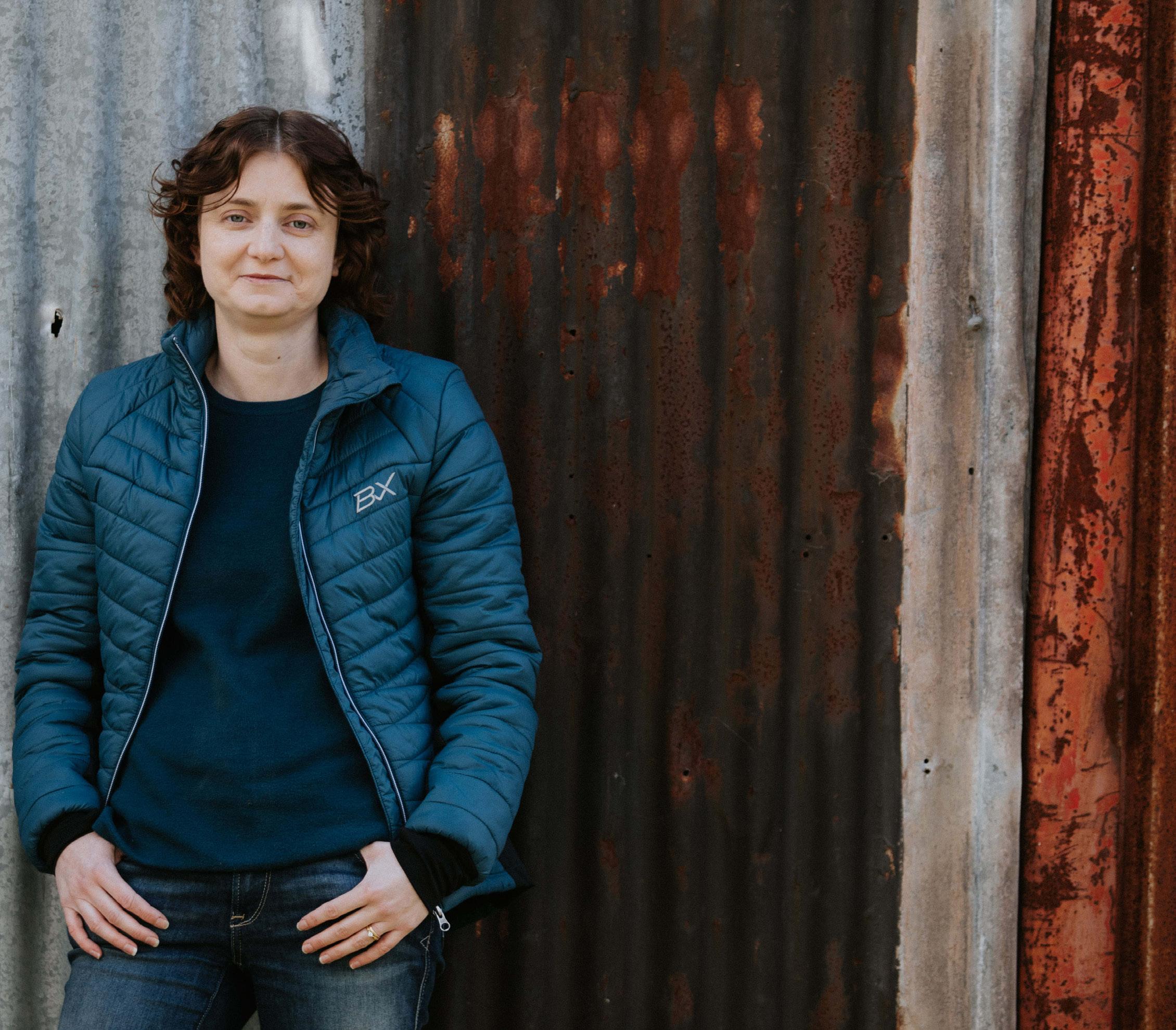
When running a small business, there’s a good chance we’ll need to be ‘thrifty’. Particularly, in the early stages.
We generally don’t have much in the way of a mar keting budget, so it becomes necessary to make the most of what we CAN do. And then trying to utilise what we do for the most gain, so we can gradually re-invest to improve and grow our business. It is clearly tempting to DIY a lot of our marketing ‘things’ to start with. And potentially, in the very be ginning of your business, you may be able to get away with that.
But there comes a time where it really does pay, to pay a professional for each different element. Hiring a website copywriter is certainly a clever thing to invest in. Often, our website is the main way in which our potential clients and customers begin to learn more about what we do and how they can pur chase from us.
And unfortunately, the content you put on your web site isn’t always an easy thing to write. Many business owners fall into the trap of simply providing a basic description of what they offer and who they are – without putting much thought into what their customers actually want and need. That can be a big problem and a way to lose customers very quickly.
Then, you have your SEO requirements. If you want to rank well on Google, to take advantage of the free traffic you can gain – one of the biggest ranking fac tors is your website content.
You will not rank well if your content is terrible. Or even, if it’s basic or just not optimised.
Plus, you’ll also tend to need regular, well-written blog posts to upload on to your site. These again help your SEO, but also help your clients and customers learn more about you. Therefore, helping them to purchase more confidently.
The trick to getting your website copywriting and blogs done well is to use this content smartly. The content or words you put on your website tends to set the entire tone of your business, your brand and your marketing.
Therefore, when you have this content written professionally and properly – it’s not a case of just using it once.
Not only do you get all the benefits of having this amaz ing content on your website, but you can actually use it right across your marketing mix.
Your website content can be repurposed into printed marketing materials, social media content and any oth er promotional content you need.
Plus, good quality, detailed blog content can also be repurposed into social media content that keeps you going for weeks, if not months.
So, let’s take a look at how you can make your website copywriting go further.
Generally, when I write for websites, at the very least I tend to write a home page, an about page and a ser vice page (clearly, this is for service-based businesses – an eCommerce store will swap the service page for another).
These pages are your absolute minimum to have writ ten well.
Home page content tends to define your overall brand messaging, key points of difference and the outcomes your potential clients or customers will receive from working with you.
It also acts as an index that points your website visitors to further information.
Home page messaging can also be used for:
• Printed brochures.
• Business cards.
• Advertisements (think magazines, newspapers etc.).
• Social media posts (simply copy and paste a sec tion of your home page content and turn it into a post with a nice image).
About pages are often poorly written and under utilised but they are actually really important.
These days, people want to really get to know who they are doing business with. Therefore, your about page is your chance to demonstrate who you are as a person and why you’re the best person to be working with pro fessionally.
They really should show your ‘human’ side, with a mix of your experience, skills and qualifications and per haps some fun personal facts, but also be written in a way that paints a picture on how you can help your potential clients.
About page content can also be used for:
• Printed brochures.
• Business cards.
• Advertisements (think magazines, newspapers etc.).
• Social media posts (simply copy and paste a sec tion of your about page content and turn it into a post with a nice image).
• Professional bio (for speaking gigs and the like).
• Awards applications.
Service pages are fairly self-explanatory, but don’t fall into the trap of simply providing a list of services. It pays to put some real thought into this.
You may also like to include a content page for each individual service. This really helps your SEO, and the extra details help your customers to decide whether your service is right for them.
(Therefore, your top-level service page would act more as an overview and a directory, pointing off to the indi vidual pages.)
Either way though, make sure there is enough detail about each service for potential customers to make an informed choice.
And then, utilise this information across your market ing material and socials, as suggested above.
Written blogs can often appear to be too time consum ing to really bother with – with many business owners preferring the more instant video mediums instead. However, blogs still carry a lot of weight with both cus tomers and Google. The thing to keep in mind however, is the longer and more detailed they are – the better they will rank on Google.
Even if you plan on writing most of your blog posts yourself, there is a lot of merit in hiring a profession al copywriter to plan and write a foundational series of longer, high-quality blogs. This can be useful in the beginning of a new business as it will show you how these blogs are best written and set the tone for when you start doing them yourself.
It also gives you some solid foundations for your SEO and gives you a great head start on your social media content.
A well-written 1000 – 2000-word article can give you around 50 social media posts. You can either take a quote and post it on your socials – or an entire para graph or section. You could even take a 2000-word blog post – and repurpose it into a 500-word mini blog post down the track.
Or, take each section of the 2000 word blog post, and turn each of the sub-topics covered into an even more detailed 1000-word blog post. There’s lots of things you can do.
You could essentially take four to six main foundation al pieces of content on your expertise and turn them into another 20 odd blog posts – and therefore have well over 100 pieces of content that you can then use as social media posts.
As you can imagine, that’s a lot of time and effort saved in trying to come up with social media content over the
first 12 months of your business.
Many newer business owners baulk at the thought of investing in a professional copywriter. In fact, so do many more established business owners. Yet, getting this done professionally can really make or break your business.

When you’re clear on your brand messaging, points of difference and key outcomes for your clients – things that generally tend to be established when working with a good copywriter – you can then use that same content everywhere else.
But it also gives you a lot more confidence and clar ity when pitching your business and your services to potential clients and customers. The more clarity and conviction you have – the more likely you are to get the sale.
It’s also really useful though, as it can save you a lot of time and drama down the track.
Getting your website content set up to rank on Google has long-term benefits – as most people will use Goo gle to find you. If you’re not ranking for your keywords, they just won’t find you.
But most of all – it ends up being such a time saver. If you find yourself needing some printed promotional material, if you want to produce a video on your busi ness or if you find yourself needing to put together an
advertisement – the content and the words are already there to use.
And instead of getting stuck for content ideas on so cial media – or having to constantly come up with new material – you already have reliable content you can fall back on. It’s ready to go.
Finally – it helps you to be consistent. You won’t keep putting out different and confusing messages to your target market. You’ll always be known for the things
that make you special, with consistent messaging. So, remember - write once, use everywhere.
Sarah Walkerden, The Rural Copywriter, is a digital mar keting messaging and strategy ace. She helps rural and regional businesses win scores of adoring customers and boost their Google rankings.
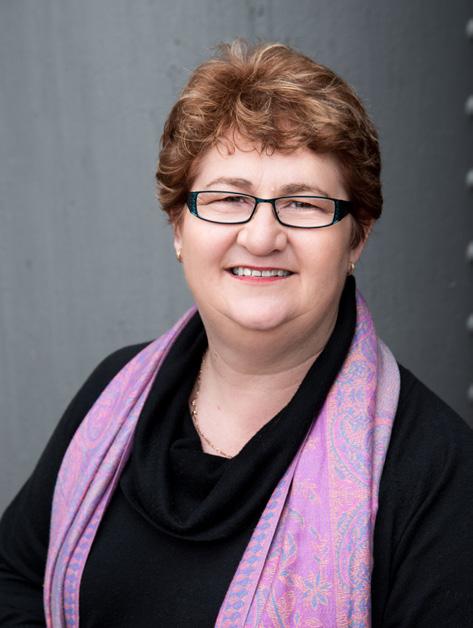

Her ‘no fluff, no bull-dust’ approach creates straight-shooting SEO Website Copy that cultivates real results, helping ‘agri’ and other rural businesses to flourish.
A country girl at heart, Sarah spent years managing websites for large corporate companies in Melbourne. Now she’s settled on her rural property in regional Vic toria with her young family, her horses and her thriving business.
also
business skills & information to assist you

have a thriving machine
business
With a strong focus on business skills, combined
computer and quilting skills, you are sure to discover courses that will both inspire you and grow your business.


(It will certainly give you far more bang for your buck!)
It can be a really great way of taking that first leap into book writing and publishing, without too much stress or drama. And taking part in these books can also help you to get published, much faster.

But many business owners don’t always know that these types of opportunities exist. And then when you find them, you might be wondering about how they re ally work and what they can truly add to your business and profile.
So, let’s take a look.
Now, this is something we wrote about in Issue 1 of Rural Entrepreneur Australia, but we’ll quickly give you a brief overview here.
Publishing a book for your business will:
• Help to position you as an expert in your field.
• Increase trust and credibility in the eyes of your po tential/existing clients and customers.
Writing and publishing an entire book by yourself can be quite daunting. Particularly, if you’re a firsttime writer.
And even though you might know that the business benefits are certainly there, producing a book to posi tion yourself and your business is still not an easy thing to get done.
However, in recent years, a new publishing trend has really taken off in the business world – collaborative books or anthologies.
This is where a group of people band together to write one chapter each (or a section), to create a profession ally published book between them. Therefore, splitting up the work and dividing the costs of publishing.
• Increase trust and credibility in the eyes of others in your industry – leading to speaking gigs and the like (which help grow your profile).
• Gives you another marketing channel and traffic source – you’ll potentially be found on Amazon and on Google, more easily.
• Help you to cut through the noise online and really stand out from your competitors (books hold au thority).
It’s also:
• Fun – it gives you a creative outlet that can break up your daily tasks.
• Provides an interesting challenge – when it’s some thing you wouldn’t normally do.
• Healing – giving you a chance to reflect and work through past experiences.
• Clarifying – when you reflect, you often see new op portunities for the future.
Writing 60,000+ words for a full-length book is a mas sive undertaking. Depending on your schedule, it could
take 6 to 12 months to write that. It doesn’t necessarily have to (as with the right writing process and support you can do it quite quickly!) – but realistically, it cer tainly can.
And when you battle first-time author issues such as writer’s block, procrastination, no accountability or support – it’s highly likely that you won’t get around to either starting it or finishing it.
Therefore, contributing a single chapter to a collabo rative book may only require you to write 3000 to 6000 words. And it also provides greater accountability and support.
So, you might choose a collaborative book because:
• It takes less time and work to write a smaller con tribution.
• The publishing costs are split between authors, which means you outlay less.
• Usually, the entire publishing process is handled for you by a professional publisher with a specialist team (less hassle).
• The resulting book is generally better quality when produced properly by professionals and with the in put of multiple ideas and suggestions from other authors.
• You have other authors to bounce ideas off.
• You’ll have access to more support throughout the writing, publishing, and marketing process.
AND – here’s the big one – it gets YOU in front of OTH ER audiences.
When authors collaborate on a book – everyone shares that book to their own audiences.
Which means your name ends up front and centre, in a credible way, on the other authors’ social media chan nels etc. This can lead new clients and customers to your channels.
Generally, a collaborative book is coordinated or head ed up by one or two business leaders. They will promote the opportunity to get involved – and you’ll apply for your spot in the book.
Many books offer between 10 and 30 spots for authors. The book will have a central theme, so you’re likely to need to pitch how your story or your expertise can con tribute to that theme or topic.
Authors are then chosen, and the leaders of the project will keep you in the loop as to the rest of the process. Everyone will run and manage these projects slightly differently. So, it is important to ensure you fully under stand what’s required by the organiser before commit ting.
This might include specifics such as word counts, whether you’re contributing a single chapter or a spe cific section, how your contribution is to be written, and when each part is due.
However, many (including ours) require you to write a single chapter of around 3000 - 5000 words.
Generally, the process can look a little like this:
• You meet the other authors and get to know them.
• You might be offered the chance to submit a few topics for the organisers to choose from.
• The organisers choose the best topics from each author and determine the chapter structure of the book.
• You’ll be given your final topic.
• You’ll then write your first draft – and send it to be edited.
• The editors will come back with suggested chang es.
• You review the changes and accept or reject them.
• The editors finalise your contribution.
And then – the publishing team and organiser handle the rest of the process.
You may also get the opportunity to review the pro posed cover design and submit your feedback and suggestions.
Finally, you’ll help with marketing the finished book to your audience – hopefully with plenty of support and templates etc. from the organisers.
Generally speaking – yes, there usually is a fee to be in volved. This might concern you, but it is standard prac tice and to be expected.
Publishing a book through a self-publishing company (like us at The Rural Publishing Company) isn’t a $2 exercise. When there’s complex elements such as cov er design, typesetting (internal design), editing, proof reading, printing etc. – all of these things take exper tise and time. And the success of a book – or indeed anything – depends on getting things done well.
The benefit, as mentioned earlier, is that with a collabo rative book each author shares the cost of publishing.
That way, it’s significantly less than trying to do it alone. Precisely what cost, again, is down to the individual project.
However, it can be anywhere from $500 through to $5000. This can depend on the cost of publishing –but also on the size of the audience you’re potentially getting in front of.
It will also depend on whether the organisers are in cluding a certain quantity of print copies for you, or if you simply order however many you feel you need, as you go.
This again, will depend on the organisers and the pub lishing house involved in the project.
Some business leaders WILL provide lots of coaching and support – others will simply expect you to write your chapter by the due date.
Some publishers will be directly involved in supporting authors, others will not.
If you’re a beginner writer or not so confident, it’s wise
to make sure you will have access to some form of support from the organisers.
But the beauty of these projects is that they are collab orative. You should have access to the other authors to bounce ideas off when needed. You’re not going it alone.
What if I’ve never written a book (or anything) before? Then collaborative books are likely to be perfect for you. In most cases, beginner writers are completely welcome.
You’ll be able to give it a go with extra support and en couragement.
And here’s the thing to keep in mind – a great editor can make any writing sound fantastic! They will make sure you sound like the polished professional you are.
So, I’ve been involved in two collaborative books so far. First, I contributed a single chapter to a larger book called Back Yourself. This was organised through a women’s business group called AusMumpreneur.
I chose to do this because they had a larger network

and audience than I did. I thought it would be a great chance to get in front of their audience in a prominent way, but to also create some great relationships with the other authors.
The project certainly did that. Plus, it gave me the ben efit of gaining a first-hand insight into the world of pro fessional publishing AND how these projects were run.
As a result, I then decided to try and organise my own collaborative book.
The idea was to do something similar to Back Yourself, but with a rural and regional focus.
Rural Business Women ended up bringing together 16 of us women, each of us running businesses from re gional areas.
Admittedly, the project challenged me far more than I expected. But the rewards have been fantastic, not just for me, but the other authors too.
We were a pretty diverse group, all in different areas across Australia, in different industries running com pletely different businesses – at different stages. Many were juggling competing priorities, such as farms and kids as well.
While the project was supposed to take 3 months, it ended up taking 12 months.
However, the diversity ensured a wide range of knowl edge and advice, which was just what I wanted. And the chance to lead these incredible women in such a big project was pretty life-changing for me.
Rural Business Women ended up topping the charts on Amazon and becoming a number one best seller in the Women and Business category. It was quite the achievement.
And many of the authors have been featured in lots of local media outlets.
Together, we’ve sold hundreds of copies. We’re impacting women right across regional Australia with our knowledge – and that’s really cool.
Plus, we decided that all eBook sales on Amazon would be donated to a regional charity. In this case, we went with an organisation called Rural & Remote Men tal Health. It’s nice to give back in this way.
In fact, this book was what prompted us to start our own publishing company, as we enjoyed the process so much. Books are such a passion of ours as they are such an affordable and accessible way of sharing stories and knowledge.
About our current collaborative book opportunities
You’ve probably guessed that we have an ulterior mo tive for sharing this insight into collaborative books. Yes – we offer our own.
We’ve well and truly experienced the power of collabo ration in so many different ways, and books aren’t any different.
The more regional business owners who can join forc es and grow their businesses together, the further we all get and the more we can all achieve as a collective. We’d therefore love to invite you to be a part of our next two collaborative titles, so you can get a taste of what being an author can bring to you, both personally and professionally.
Book 1: Rural Business Women Volume 2 – this is de signed to follow on from the business basics provided in Volume 1, to provide slightly more advanced infor mation.
Book 2: The Rural Rebel Business Revolution – this is all about how you might be doing things differently in business, to get ahead.
We have a maximum of 20 author spots in each book. If you’d be interested in getting involved, or have any questions, feel free to get in touch with us. Or simply go here: https://theruralpublishingcompany. com.au/collaborative-books/
Sarah is a multi-award-winning copywriter and market er with over 18 years’ experience. She holds a Bachelor of Technology and is recognised as a CPM (Certified Practising Marketer) with the Australian Marketing In stitute. Sarah is also a best-selling author of multiple books.
Toby is an experienced business founder, with multi ple businesses and accolades under his belt. His cur rent business, Billing Metals & Manufacturing, supplies specialty metals and element samples to schools, uni versities and amateur scientists.
They love nothing more than combining their skills to empower like-minded rural business owners and re gional authors to succeed.
More information: https://theruralpublishingcompany. com.au/
matter what stage of business you’re in, whether you’re starting out, growing, or reas sessing, it’s imperative that you have the right business structure. It can help you minimize risk, reduce tax and increase profits.
In this article we discuss the basics of business struc tures. It is recommended that you discuss these mat ters with your accountant and lawyer. This is so that you can make an informed decision about which busi ness structure will suit your specific needs.
Sole trader arrangements are a low-cost option for peo ple starting out in business, which appeals to many.
It is important, however, to remember that sole trad ers are responsible for everything that happens in their businesses. The sole proprietor is responsible for 100% of the business liabilities, which can be recovered from their personal assets.
Sole traders declare their business income (or loss) as part of their personal income tax return and are taxed at the same rate as an individual.
While a sole trader arrangement may be suitable at the start of your business journey, as you grow, take on more risk, or add other people to the business, you should then consider the other options available.
A partnership is a bit like a sole trader with more than one person. When starting out with 2 or more people, a partnership can be attractive, again due to the low costs of setting things up.
A key thing to consider is that a partnership is not a separate legal entity. Generally, in a partnership all part ners will be equally responsible for the management and liabilities of the business. Usually each partner will have unlimited personal liability for the debts and obli gations of the business. If the partnership cannot meet its debts, creditors can seek to recover loss from the personal assets of one or more of the partners.
This may mean that if one partner has more assets, they will bear the responsibility for the partnership’s loss. If one partner has limited personal assets and another owns their home for example, a creditor may recover some or all their loss by requiring that one part ner to sell their home.
It may seem like the last thing you want to do when starting a new business venture. However, it is prudent to consider what should happen if the partners want to part ways or are otherwise in dispute. While having a few heads in the business can be very beneficial, there is also the added risk that the partners may not be able to agree on issues.
Having a partnership agreement prepared can set out the expectations of each partner, which will minimize the risk of a dispute (where parties are clear on their rights and responsibilities), assist with resolving a dispute, or make severing the partnership easier (if re quired).
Using a company structure can mean increased set up and ongoing costs, as well as more complex reporting requirements and administrative burden.
A company is said to have a ‘corporate veil’, which means that the company is a separate entity from the
individuals behind it. A key benefit of this, which makes it the most popular business structure, is protection for those running the business. A company structure seeks to balance the interests of those behind the business, by encouraging growth while shielding the individuals from risk (by limiting their liability for business affairs). There are limited circumstances where those behind a business can have personal liability, and if you are setting up a company, particularly if you are to be a di rector, you should be aware of your duties and respon sibilities. There are lots of helpful resources available to help you with this, as well as professional advisers. It is easier to enter and exit a company, which makes selling or passing the business on, as well as bringing people in, simpler.
A key document for your company will be your consti tution, which dictates how your company will be struc tured and operated. You should also consider whether a shareholder agreement is necessary where there are multiple shareholders.
The tax requirements for a company are different to those of other business structures. A company pays income tax on its income (or profits) at the company tax rate.
A trust structure can also be implemented within a business. A trustee is responsible for the trust’s income and losses, and can be an individual or a company.
To maximize tax benefits, family businesses often use trusts to distribute income between members.
Your business is held in trust by a trustee for the bene fit of other people (the beneficiaries).

Trusts can be complex and require an initial trust deed to establish them.
It is important to explore your options when setting up your business to find the right business structure for you.
In the case of a sole trader or partnership, you may be limited by your structure over time, particularly if you experience significant growth.
You will be able to maximize your business potential and minimize your risks if you have a team of trusted business advisers on your side.








 By Deb Purvis - Purvis Agri Finance
By Deb Purvis - Purvis Agri Finance
The relationship between financier and farmer is vital, as the financier is an investor in the farm business. It’s important to provide financiers with timely, accurate and relevant information. In both good times and bad, this will help you access more compet itive and appropriate finance.
Preparation is key when you’re applying for a bank re view or a new loan application.
It gives the financier confidence that you know your business and can plan, manage risk, and are a disci plined financial manager.
Begin by identifying what information the financier needs and present it to the bank as a report which in cludes:
• asset and liability information
• historical management reports
• cash flow budgets
• a farm plan
• risk management and succession plan.
Make sure you highlight the assumptions you’ve made for the income and expense items in the budget.
Consider using a professional adviser who under stands banking requirements, so they can assist with preparing the report.
Most importantly, it’s vital that producers understand the information they are presenting.
The financier will quote a base rate and then add on a customer margin. This margin is unique to the person and their business. It’s determined by the financier’s perceived risk in lending money to the business.
Understanding how financiers determine their lending margins and set their interest rates will assist with fi
nancial negotiations.
The 2 most important numbers are the:
1. Official Cash Rate - set by the Reserve Bank of Aus tralia (RBA)
2. Bank Bill Swap Rate (BBSW) - set by the market.
Every day, banks have transactions to execute, includ ing retail and business purchases, credit card pay ments, payroll. There’s no reliable way of predicting how much those transactions will be. Inevitably, some days, banks will have more money going out than coming in.
So, they need to borrow cash. Where do they go? The bank.
The cheapest way is an overnight loan based on the Official Cash Rate (currently 1.85%). The next cheapest way is through short-term loans (1 - 6 months). These are loans between banks in the wholesale markets based on the BBSW (currently 1.82% for one month or 2.93% for 6 months).
The 6-month BBSW is higher than the cash rate, so banks are paying more to cover their cost of funding. Connected to this is the Bank Bill Swap Yield (BBSY).
This is the reference rate when setting customer fund ing costs in the business lending market, equivalent to BBSW + 0.05%. If you have a market rate loan, you’ll
see this referred to in your letter of offer when the bank quotes your interest rate. Put simply, this means that if BBSY goes up, you pay more interest.
Banks, like every other business, want to make a profit. They set their lending rates to maximise their profitabil ity of lending. But they also need to manage the risk that some borrowers won’t repay their loans.
As lending rates increase, demand for borrowing could decrease, which could reduce the bank’s profits. It’s a balancing act.
They consider the following factors when calculating this margin:
Cash flow – does the client have the capacity to gener ate cash to meet their costs?
Character – honesty, previous conduct and manage ment abilities.
Outside factors – how would the death of a partner, marriage breakdown, health, or drought affect the business?

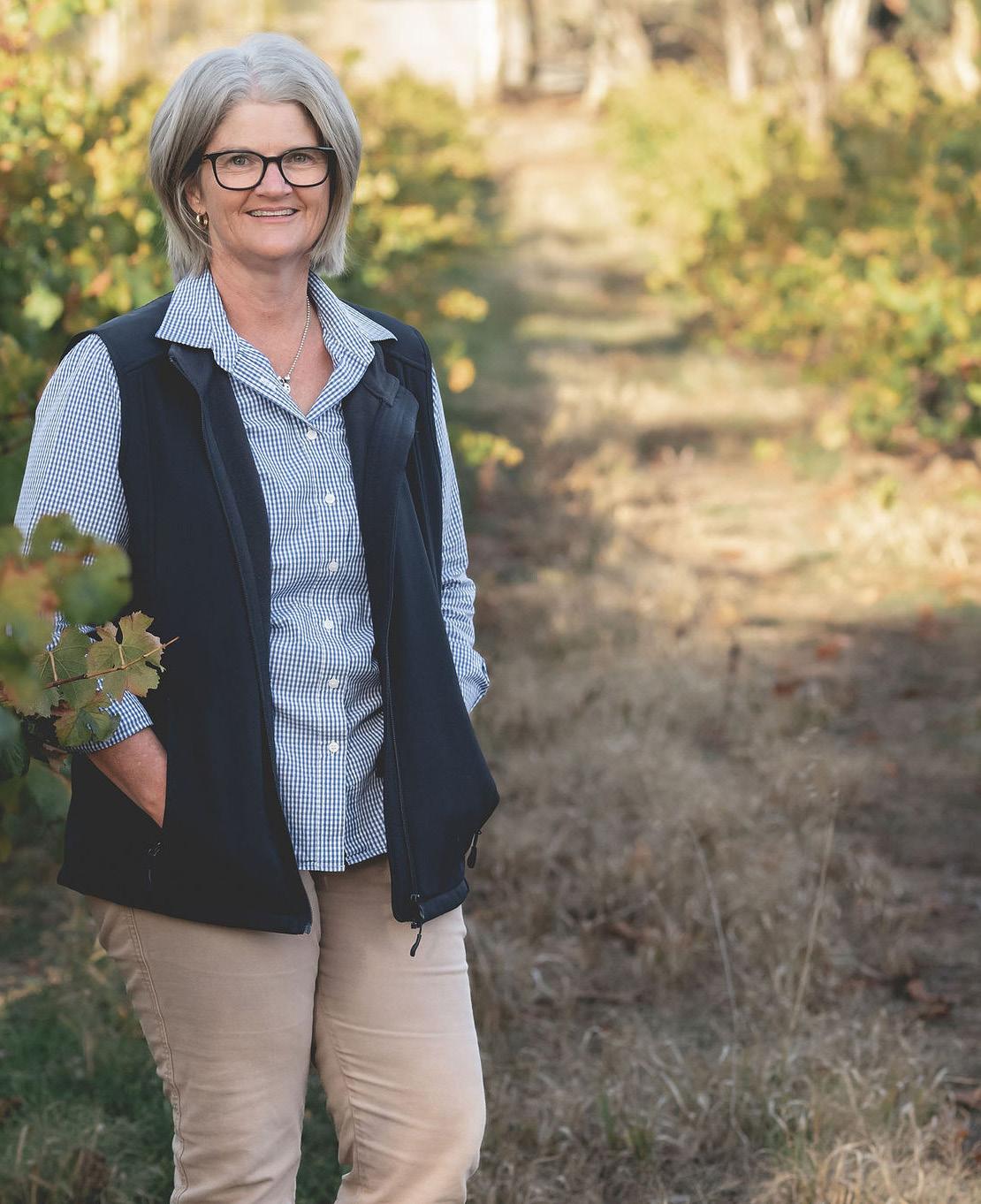
Capital – equity position. The higher the equity, the lower the risk.
Risk profile –can the business manage external risks, like industry downturns, climate variations, and inter est rates?
Security – what security can you offer? Is it saleable and is its value sufficient for the loan requested? The lower the ‘loan to value ratio’, the lower the risk.
This is the negotiable part of the loan and there are strategies we can implement to reduce the customer margin:
• Provide information as requested and be open and honest with the financier.
• Have confidence in yourself and in your business plan.
• Know the content of cash flow projections and be prepared to explain the numbers. Understand fi nancial statements and be able to explain seasonal anomalies.
• Have strategies to manage external risks.
• Understand your industry and current policies and trade conditions that may affect it. Discuss the customer margin and ask how you can improve it.

• Be prepared to shop around. The finance market is competitive.
Well, banks still need to lend money. That’s how they make their profits.
As rates increase, it’s important to manage your debt proactively. You need to work on the parts of your debt strategy that you can control. If you haven’t paid atten tion to managing your debt risk (loan terms, interest rates, covenants, and your lender), you’re probably pay ing too much for your debt.
You should always review and manage your debt strat egy regardless of the market conditions. But in the cur rent uncertain market, it’s more important than ever. So, don’t blame the banks.
It’s up to you to manage your debt and get the best rate for your circumstances.
You need to ensure your debt strategy is appropriate and flexible to see you and your business through the variabilities of agriculture.
Providing funds is the financier’s business. There’s an expectation they lend and generate business. So, while they need to ensure the proposal is sound, the custom er has some power when borrowing money.
Provide a sound, well-thought-out proposal and deliver it in a confident and positive manner. Doing this will help you get competitive rates and the most effective loan structure for your business.
I’m not your average finance broker.

I understand agribusiness because I’ve been part of it. I grew up on a cropping and sheep farm in Mid North SA and I’ve supported my husband in his career managing farming businesses through change. For nearly 25 years, I’ve been working in agribusiness and finance.
I started out as a bookkeeper for farming businesses before spending 10 years as a Rural Financial Counsel lor. I worked with farmers, as they made life-changing decisions about their farming businesses.
Over the last 5 years, as a partner with Robinson Sewell Purvis, I’ve supported clients across SA, WA, VIC and NSW. Through my volunteer board positions with the Hart Field Site Group and Fat Farmers, I continue to support local farmers.
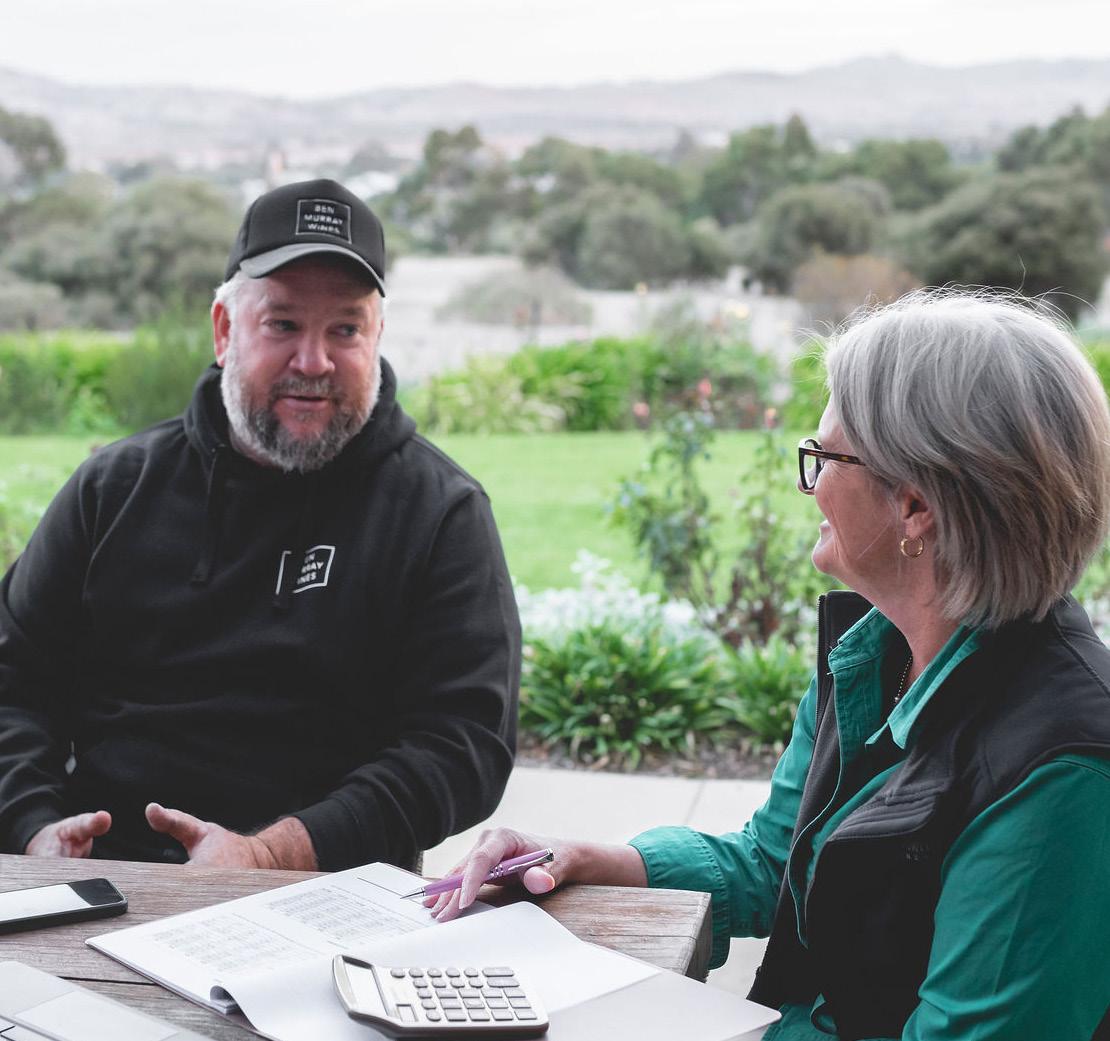
I’m proud to have won the following industry awards:
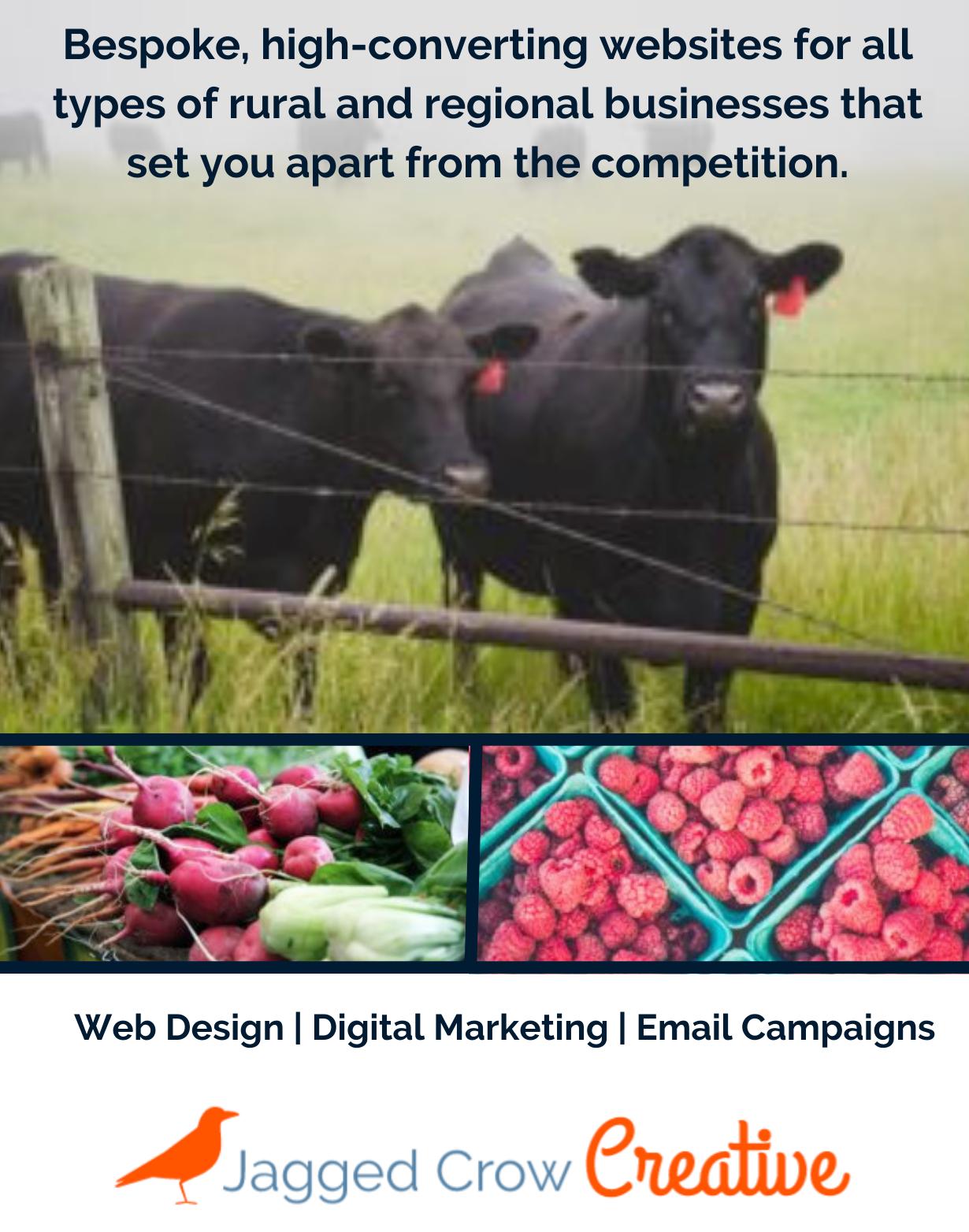
• MFAA State Finalist 2021 Regional Finance Broker Award
• MFAA State Winner 2021 Commercial Finance Bro ker Award
• Connective State Finalist 2021 Commercial & As set Finance
• Connective State Finalist 2020 Commercial Broker of the Year.
Website: https://purvisagrifinance.com.au/
 By Maree McPherson
By Maree McPherson
Congratulations on embarking on a new Chief Execu tive job!
The first 100 days in a new Chief Executive role could well offer your most significant opportunity and chal lenge.
There are huge expectations of you — the excitement
of the honeymoon period and the adrenaline of pres sure.
The initial four weeks are about discovery, the critical month for unpacking everything. It’s a time of forensic exploration — getting a feel for what’s happening and making sense of it all.
I often reflect on this time as being given a set of Rus sian babushka dolls! Which one ought you open first?
Knowing which doll you’ve opened and how many more are inside can be tricky.
In 2019, Niamh O’Keeffe published the 2nd edition of her book Your First 100 Days: Make maximum impact in your new role.
A few of O’Keefe’s recommendations:
• Understand your critical challenges.
• Recognise that your EQ (emotional intelligence) will be as, if not more, important than your IQ.
• Develop your essential personal factors of success.
to benefit from introspection - not simply inspection.
I agree. It helps to focus internally, stay visible to your team, and observe operations. Fast action might not be wise.
In month two, you need to focus outside the organisa tion.
Here’s my take on what you should know by the end of week eight:
• how the organisation is perceived externally and who your best allies/critics are,
• the methods your team is using to measure results

• the jobs you need to keep hold of and what you can delegate
• how you will empower people to enable them to get on with it.
The reality check occurs in the third month — the hon eymoon period is now over.
Your mind naturally turns to the questions you still need to answer. You have problems to fix and tough advice you didn’t want to hear.
By now, you will be wrapping up:
• your observations about the organisation, poten tial new partnerships, structures, and effectiveness measures
• meetings with key stakeholders
• an approach to your first six months to effectively measure your results.

It is the critical period to manage your energy and your health.
In the first month, you need to search for clues and ev idence and ask probing questions. Interview staff, lis ten deeply, and understand how their days unfold.
TED X Speaker and MD at consulting firm BCG, Rose linde Torres, and her colleague, Peter Tollman, say it’s a fallacy that “new CEOs should look outward and move quickly.”
Instead, they point out that the first 100 days are a time
what she sees, hears and feels. Maree helps develop organisations into legacies by assisting people to think and make sense of what they discover.
Maree’s leadership experience spans over 35 years and includes a chief executive role in a peak body and another in a regional development organisation.
Writing for Harvard Business Review, Neal Kissel and Patrick Foley suggest that new leaders must manage energy, relationships, and information flow.
You need to plan for the support structures that will sustain you and practice self-care. It will be evident that time management will always elude you as a leader – and restoring your energy lev els is a priority.
Kevin Coyne and Bobby Yerramilli-Rao, in their 2005 guide for the CEO-elect in McKinsey Quarterly, quote one CEO as saying, “Frankly, in this role, you don’t need substantive help so much. You just need a sounding board, and sometimes you just need to feel less lonely.”
Avoiding loneliness in leadership is crucial. Finding an independent and external confidante or mentor will make a significant difference.
Below, I have listed my Guide to 7 Key Questions New CEOs Should Ask.
The aim of these questions is to build your awareness of the organisation, the Board, your team, and yourself through deeply listening to other people’s views.
The learning is in how this helps you understand others and how you use that information in your future plan ning.
1. What do you want to keep?
2. What do you want to change?
3. What do you want me to do?
4. What are you afraid I will do?
5. What do you want to ask me that you can’t or won’t when we are in public?
6. What would you like to be able to rely on me for?
7. What one piece of advice would you give me right now?
Go well in your role and create the space to celebrate this important milestone.
With a strong belief that impact follows insight, Maree McPherson’s gifts bring organisations to life through
Now her clients include ambitious individuals and lead ing organisations. Maree has worked with leaders and teams within organisations to embrace lifelong learn ing and create a legacy. Her proven strategy revolves around helping leaders thrive at work by teaching them how to deliver the clarity that drives certainty.
The author of two books and with postgraduate level training in executive and organisational coaching and business management, Maree is a renowned coach and consultant facilitator in Australia.
She is one of the 4.1% of coaches in Australia and New Zealand serving as a member of the International Coaching Federation—the largest professional coach membership and credential-providing body globally. Maree works within the professional ethics and guide lines designated by both the International Coaching Federation and the Standards Australia HB 332-2011 for Coaching in Organisations. She is an accredited practitioner in the Mayer-Salovey-Caruso Emotional In telligence Test (MSCEIT).
www.mareemcpherson.com.au

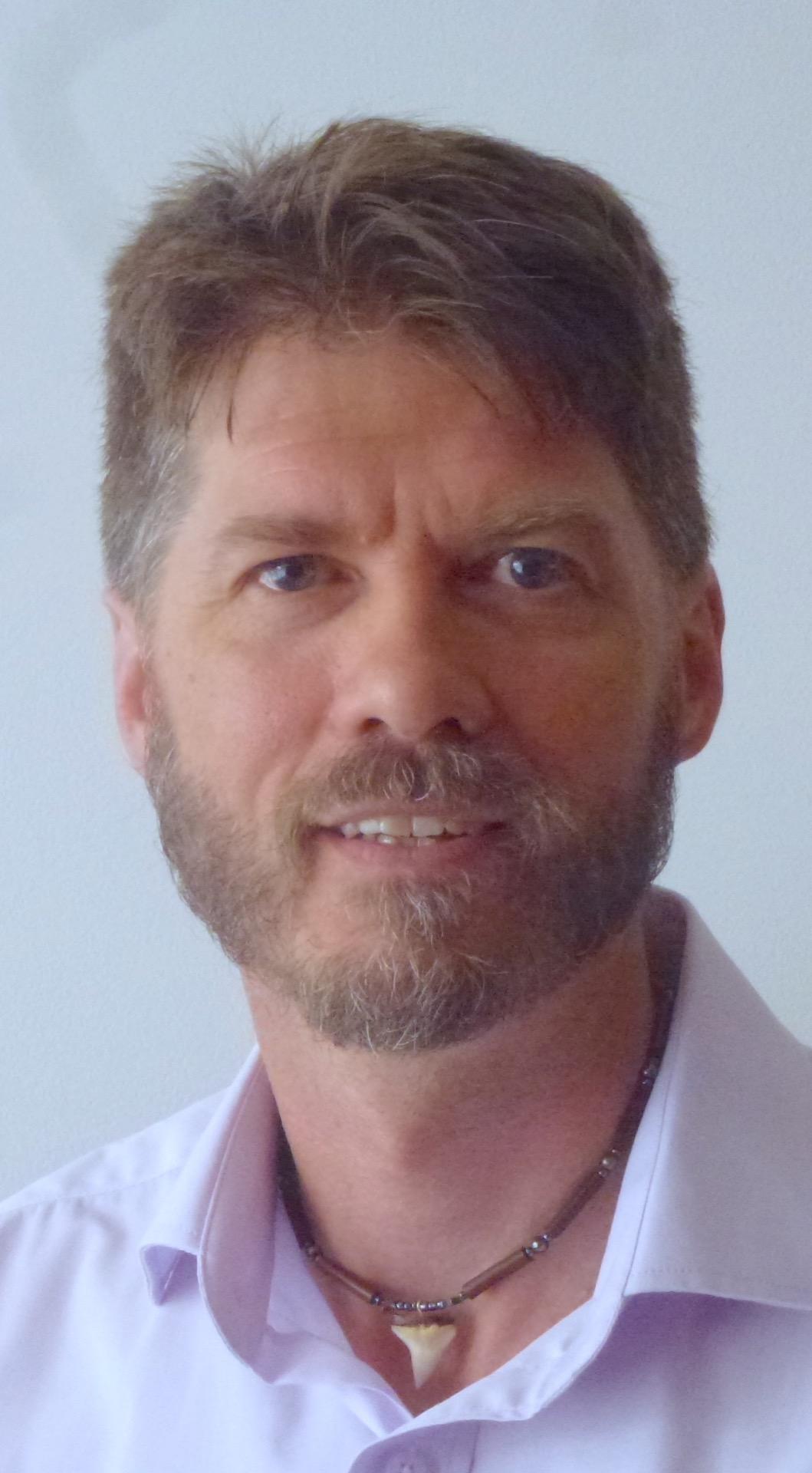
in tech and I can tell you honestly, it’s over whelming. And I make it my life to be in it as much as possible! So it makes me wonder, how do busi nesses focus on providing their amazing products and services, stay up to speed and not get left behind at every turn?
Beyond the updates and the subscriptions and the ‘new & improved’, there’s the thing that replaces this, and the thing that replaces that. Then there’s the new thing that removes the need for this old thing. But then, don’t you want to add on another thing to make these
other things easier to manage and run?
Now this is where I’m supposed to say, it isn’t THAT hard, you just need to buckle down and focus. Set your priorities and crack on.
As a business owner, that’s dead easy, yeah? You’ve got all the time in the world?
Thankfully, not all tech needs to be hard or complicat ed to understand.
So, what is the simplest step to bringing tech into your business? It’s a lot more humble than you may realise.
It’s your business card.
Why should you focus on that paper business card?
Let’s dive into some stats:
• Annually, Australia consumes around 100,000,000 paper business cards.
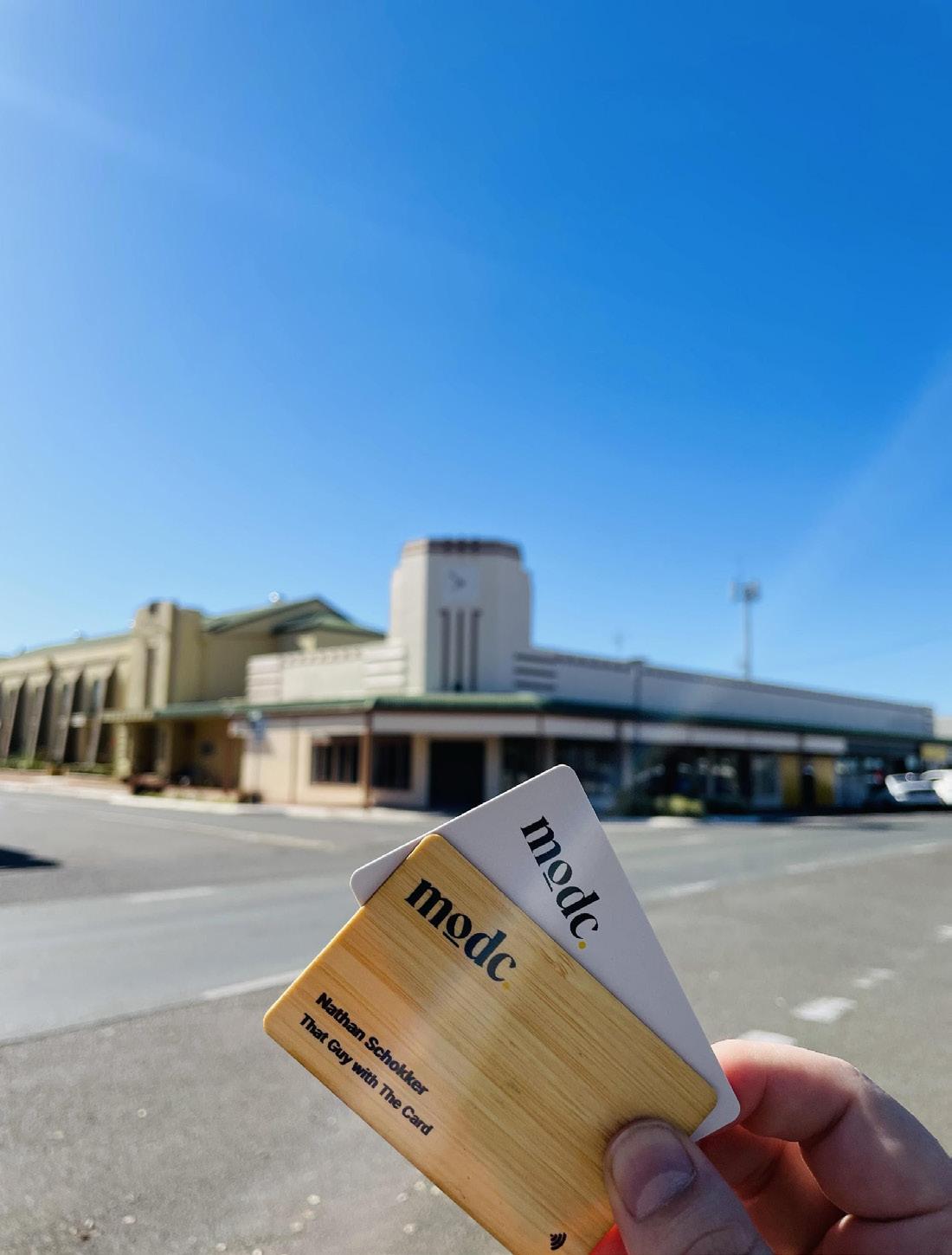
• It costs 7,000,000,000 litres of water to make just those cards for Australia.
• Each kilogram of paper cards equates to roughly 2 kilograms of CO2 produced. That’s before trans portation of any kind.
• One third of all cards never get given to anyone, ever.
• 88% of cards exchanged are in the bin within 7 days of being given to anyone.
• Of the cards that make it to someone, only 8% of those people save your details.
So of that box of 500 cards you have:
• 160 will never find their way to anyone, just the bin,
• 299 will find their way to the bin within a week of being given out, and,
• From your whole box, 40 might be looked at long enough to save your details.
Hopefully you can see already, that this tech change just made the environment a much happier place (and your wallet, likely). But, what am I actually talking about?
Your simplest step in tech should be evolving what has been pretty much the same thing since the 15th century. An often discarded (and unwanted) piece of paper that can quickly become out of date and useless with the speed of change to your business.
We propose you make the change to a digital business card, allowing you to hold only one card but with an intuitive and easy digital profile to back it up. This then becomes the place where you can share your website, your socials, your projects, your inspiration, and your self.

But did we make it painful with elongated setups and refreshes and updates? Nope. Just 10 minutes is need ed and you’re rocking. Simple as it should be, and just like I promised.
Now, with your tech forward business card in hand, all you need is for those you’re connecting with to have their smartphone, or your own as backup. With a tap using NFC (the same tech as Apple Pay, Google Pay & Tap N Go), or scan of a QR code (because we all know these things), your profile with contact details are there and ready to explore. When it comes time to update your profile, straight from your smartphone in as little
as 20 seconds – no apps or software needed. Beyond our hope that this card will make your life a bit easier, help your business and yourself shine a little brighter and make the environment a lot happier, we’d love to see these cards spark a movement within your self and your business to explore and play with tech nology a little more.
Yes, it is overwhelming to try and stay up to date with all the tech changes that happen, thankfully that’s not your job. Focus on the tech you already interact with and explore improvements you can make with it. Then, explore tech that can make your business and yourself just that little bit better.
It’s a lot easier, and less time consuming, than you may think when you take it step by step.
Remember, choose the simplest one first!
Nathan Schokker is co-founder of SafeCo, a technol ogy business born during the times of COVID initially with SafeVisit, Australia’s only community born and bred digital contact tracing system. This evolved into SafeTicket as the local solution to event ticketing and now as MODC, solving the wastefulness of paper busi ness cards whilst helping businesses better connect with their prospective and current clients.
The only thing guaranteed to irk regional and ru ral folk more than chronically patchy or non-ex istent internet coverage is continual assuranc es from big telcos in city offices that it’ll be fixed ‘soon’.
Most communities outside the major cities and towns have heard it all before. Instead of hollow promises, all they want is access to the same reliable connectivity that city people take for granted, so they can partici pate fully in a world that’s becoming more digitally de pendent every day.
As someone who grew up in a Victorian regional town, and now lives with my young family on a small farm in Gippsland, Victoria, I have lived through struggles with connectivity my whole life. I grew up on dialup, impa
tiently watching a little circle go around and around on a computer or phone screen, crossing fingers that the email would send, or the file I needed to download would complete before the connection completely dropped out.
That’s why I’ve found my background invaluable for my role as CTO within a company who holds a strong focus on building out a network with the primary aim to make a real and lasting difference for regional and rural people.
Having lived at the narrow end of the internet pipeline for most of my life, not only do I understand, but I get to see the effects first hand throughout the communi ty and hear exactly what our customers are saying –mainly because they’re my neighbours.
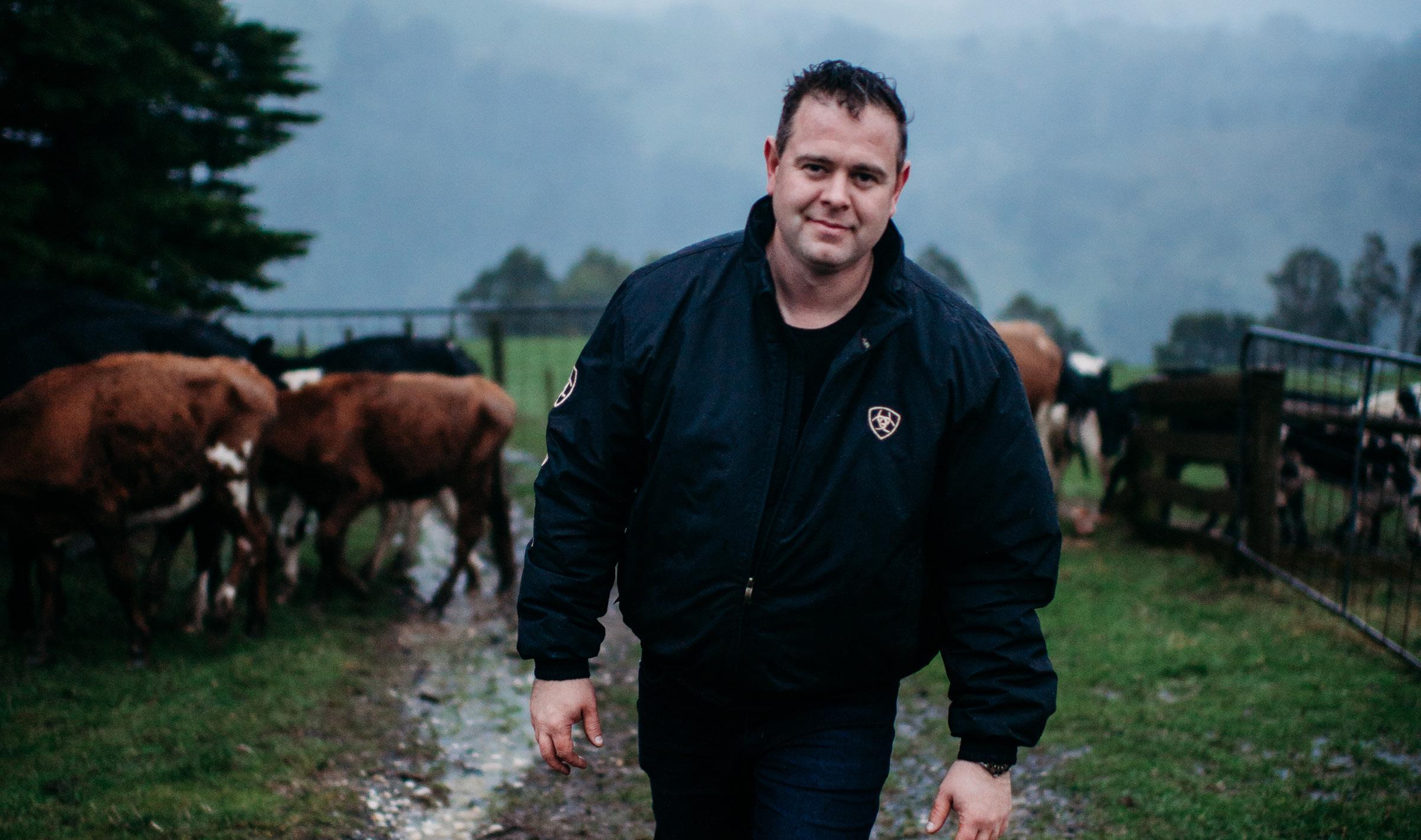
While it may seem a paradox – a Chief Technology Of ficer living somewhat off the ‘grid’ – it’s a gap that oth er telcos aren’t filling. For decades, the big telcos have been spruiking that our problems will be solved by the next big technology.
Whether it be tree-changing white-collar professionals looking to embrace the opportunity to work from their rural home, or their kids who need access to virtual classrooms and school materials.
Farmers whose very viability depends on embracing automation, using GPS to sow their crops, accessing crucial real-time weather data, automating farm opera tions, or tracking stock.
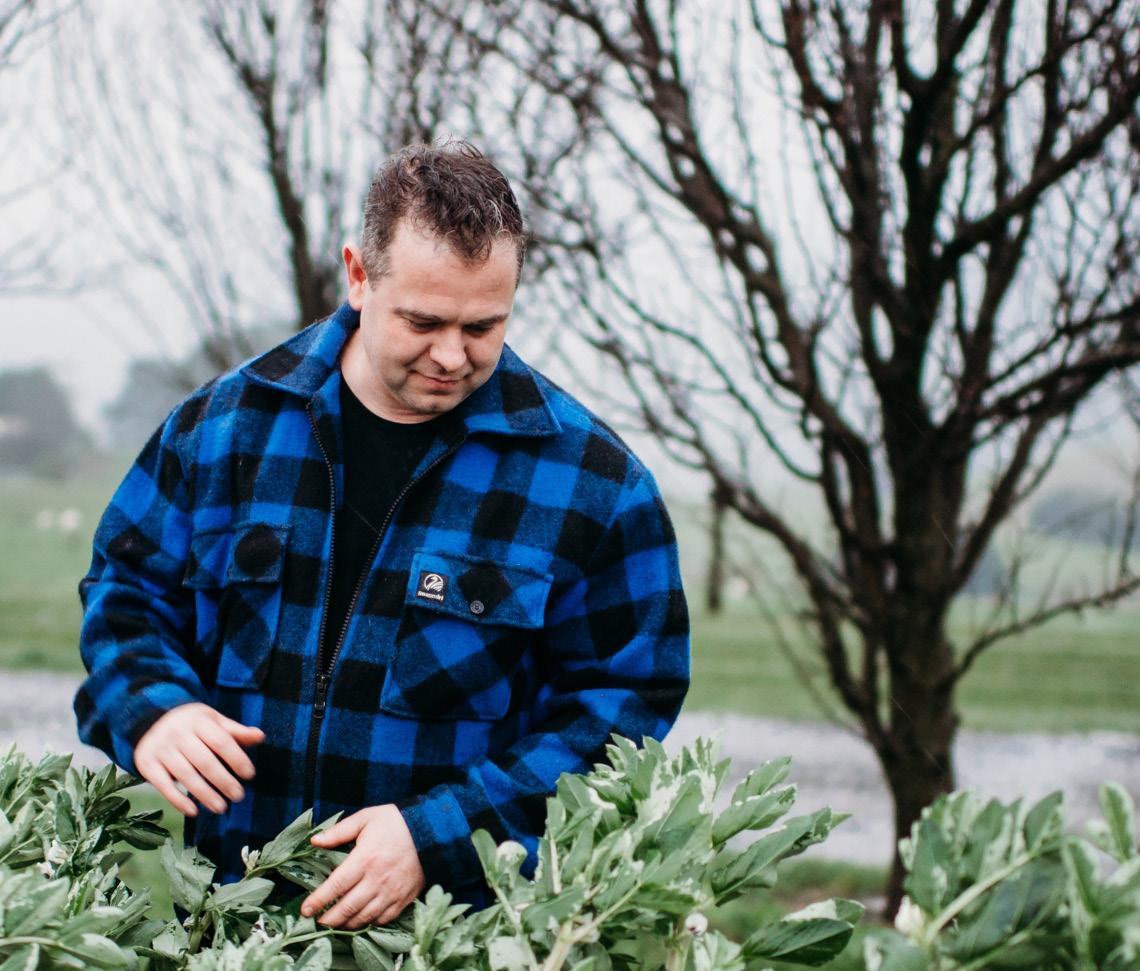
Or even the elderly residents in regional nursing homes whose day is made by a simple, uninterrupted Face Time chat with their cherished grandchildren – it’s real people that need real results.
There are a lot of conversations in our communities about the possibilities that a service like Swoop’s could create. Safe to say we’re hearing a lot of enthusiasm for someone to step up and finally give the bush the service it deserves, and to offer locally based customer service rather than sending calls to an offshore centre. Initially as CIO, and now as CTO of Swoop, I am proud to be a part of a customer-centric team building our fixed-wireless network to provide a viable internet and telecommunications alternative to the major telcos. We know how incredibly important it is to get it right for a market that has been dominated by a small number of large players for so long.
The people we talk to are keenly aware not just of their personal needs, but the important bigger picture that connectivity is going to be essential to building vibrant, viable communities.
They’ve already witnessed the pandemic-driven shift in demographics as more and more urban dwellers relocate to acreage and embrace the work-from-home lifestyle. They know, too, that global tech firms and major government departments would love to set up regional bases and call centres, to help reduce their costs. Meanwhile, quantum shifts in technology such as virtual reality are just around the corner. These will have life-changing implications, but only for those with infrastructure modern and robust enough to support it. All of this only serves to strengthen our resolve to break through the digital impasse that’s been holding back the amazing people of regional Australia from downloading the bright future they deserve.
About Tom Berryman – Swoop Holdings Tom Berryman is the Chief Technology Officer (CTO) for Australian ASX-listed telco Swoop (ASX:SWP). Tom oversees the team driving the innovation that em powers the rapid rollout of Swoop’s fixed wireless net work to regional and rural Australians.
He was also the co-founder of wholesale telco ser vices provider AnyCast and founder of NBN reseller DCSI Broadband. Both were acquired by Swoop Hold ings in 2020.
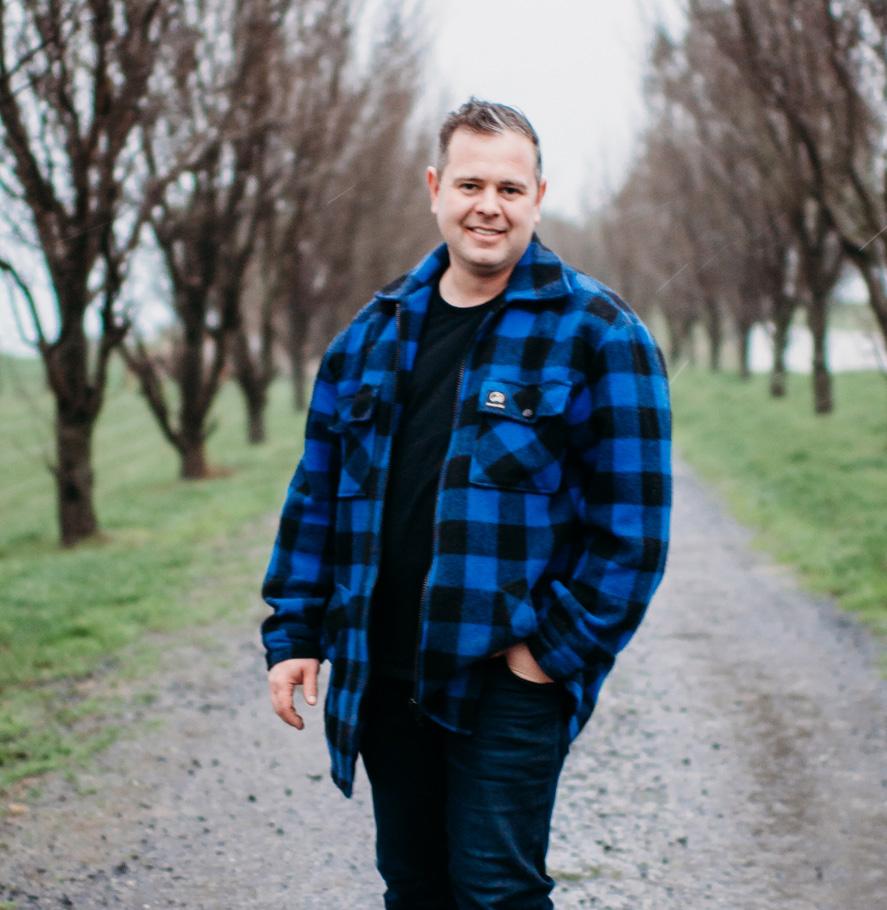
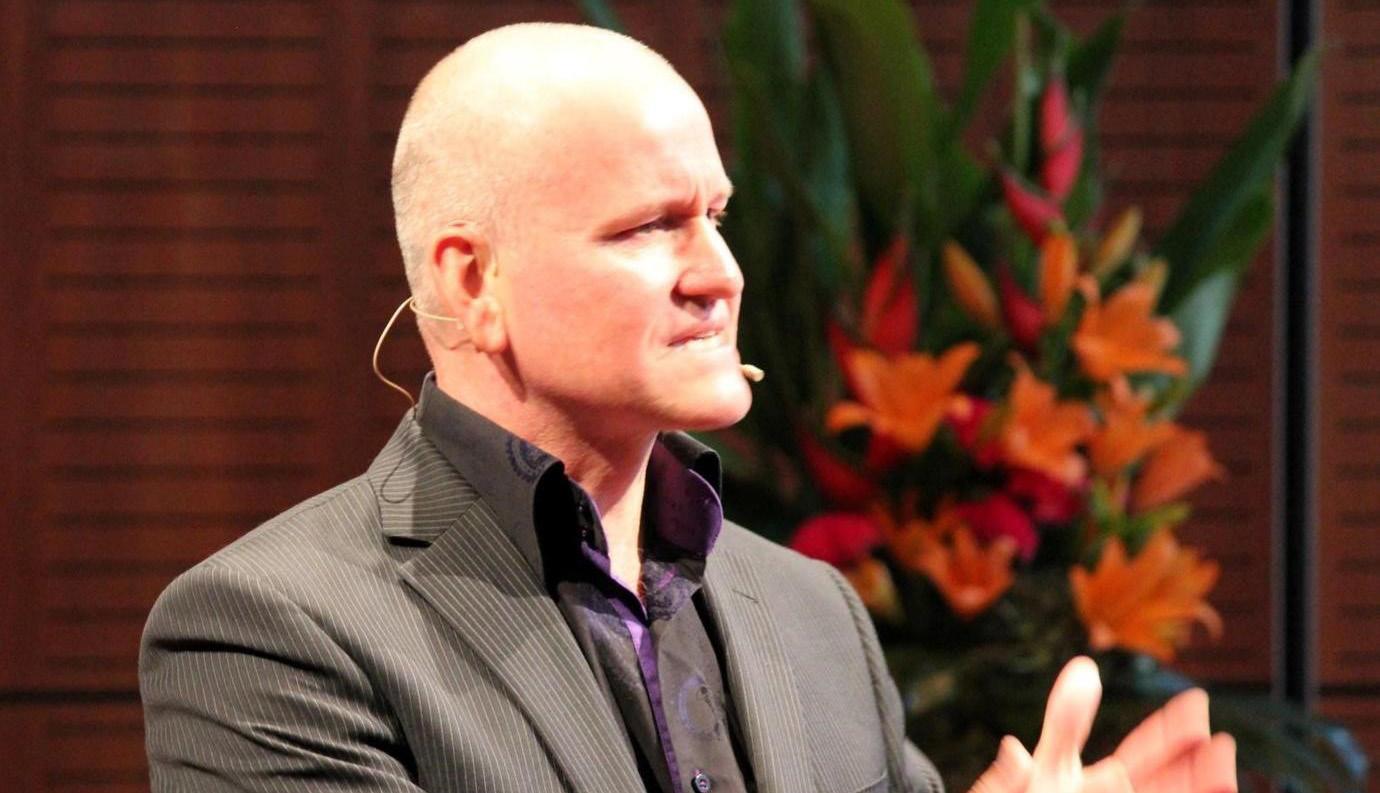
It is now possible for anger to be alleviated from our lives and more-so it’s easier than you might think. More and more people are learning how to reduce the hold that anger has on us.
What is anger? What is the real cost? And what can we do to get to the very source of anger and remove it from our lives?
Let’s start with the biochemistry and the physiological effects of anger.
From a neurological perspective, anger triggers the body’s ‘fight, flight’ or ‘freeze’ response and initiates other emotions such as fear, excitement and anxiety. In other words, it activates one of the oldest parts of our brain – the reptilian brain.
Once engaged, our brain instructs our biochemistry to gush a river of destructive chemicals into our bodies to prepare us for the ‘flight, fight or freeze’ responses to danger. For example, the adrenal glands flood the body with stress hormones, such as adrenaline and cortisol. These chemicals are our last resort chemicals and while intended to save us from a threat, they can harm our bodies.
Besides the most obvious negative effects of anger such as relationship breakdowns, loss of career, exces sive use of drugs and alcohol – outbursts of anger may actually trigger heart attacks, strokes and other cardio vascular problems in the two hours immediately after wards. This is according to the first study to systemat ically evaluate previous research into the link between extreme emotion and all cardiovascular outcomes.
One such study, was led by Dr Murray Mittleman (MD, DrPH) who is director of the Cardiovascular Epidemi ology Research Unit at Harvard Medical School, Asso ciate Professor of Medicine and Epidemiology at the Harvard School of Public Health and a cardiologist at the CardioVascular Institute at Beth Israel Deaconess Medical Center.
If we experience anger daily or even weekly, we are con taminating our bodies with adrenaline and cortisol and the evidence from numerous studies is clear. Constant chronic anger, hostility, and aggression raise our risk of developing various deadly forms of heart disease by as much as five times the normal rate. The more hostili ty we tend to express, the more we are prone to heart disease.
If you find that you immediately get angry when you have to wait in traffic or when confronted with a long line at the grocery checkout, or if you find yourself con stantly yelling at your loved ones, you may be slowly killing yourself.
Anger is both a physiological and psychological pro cess. In other words, Anger affects our mind and our body. Because of this, anger can have a negative im pact on our physical and emotional health. This is par ticularly true of the relationship between anger and heart disease.
There is a direct connection between being constant ly angry, competitive, and aggressive, and early heart disease. For example, recent research suggests that men who have poor anger management skills are more likely to suffer a heart attack before age 55, than their more emotionally controlled peers.
A separate study indicated that older male subject’s hostility ratings (how hostile and irritable they tend to act towards others) predicted heart disease more ac curately than other known risk factors including cho lesterol, alcohol intake, cigarette smoking and being overweight.
For over 30 years anger researchers have known that the most common behavioural response to an episode of anger is to have an argument. Though the forms of argument in today’s society are wide and varied and more harmful than ever. A vast array of weapons are used from guns, knives, blunt instruments to social media. All can have lasting and devastating effects. The function of anger is usually to communicate to another that the behaviour being demonstrated is not desirable or acceptable. It is to recalibrate the target of the anger, by showing the target that they will be worse off by continuing to behave in specific ways. Anger toward another is usually initiated when a per son feels that their interests are not being considered. Anger toward a situation often comes from fear or
frustration that we cannot cope with the task or tasks at hand.
Primitive thinking, even among today’s humans, sug gests that one’s bargaining power increases when we act angrily. We can raise our voice, raise our fist or per form various feats of linguistic jujitsu.
Individuals that believe in this theory believe more bar gaining power will allow them to be more successful and therefore will set lower thresholds for anger. An cestrally, the two primary sources of bargaining power were the ability to impose costs, such as aggression, and the ability to withdraw or remove benefits.
Hence, strength, power and intelligence are still highly regarded in today’s society.
More educated ways to deal with anger is certainly one solution to an angry outburst, however even the highly educated and the skilled communicators suffer from uncontrolled anger. Anger has a source and in order for us to increase our Emotional Quotient, we must first deal with the source.
Anger is just a by-product of that source. It is a form of fear and we are all capable of fear and being angry. Anger often has little to do with a situation, such as a partner leaving the cap off the toothpaste. While we don’t have control of our spouse leaving the cap off the toothpaste, it is usually just a trigger of something larger. Anger usually builds from frustration, often from situations that are out of our control. When we get to the source of our frustrations we can all reduce anger in our lives.
Anger is a stored neurological memory chain and at Life Beyond Limits we have a proven method of reduc ing anger. We help our clients reduce anger in their lives by breaking those angry memory chains and teaching our clients how to reframe negative, angry events with a neurological repatterning process.
R!k Schnabel is Australia’s #1 Brain Untrainer. He is a Master NLP and Life Coach trainer, Coach and an in ternational, multi-best-selling author with Life Beyond Limits.
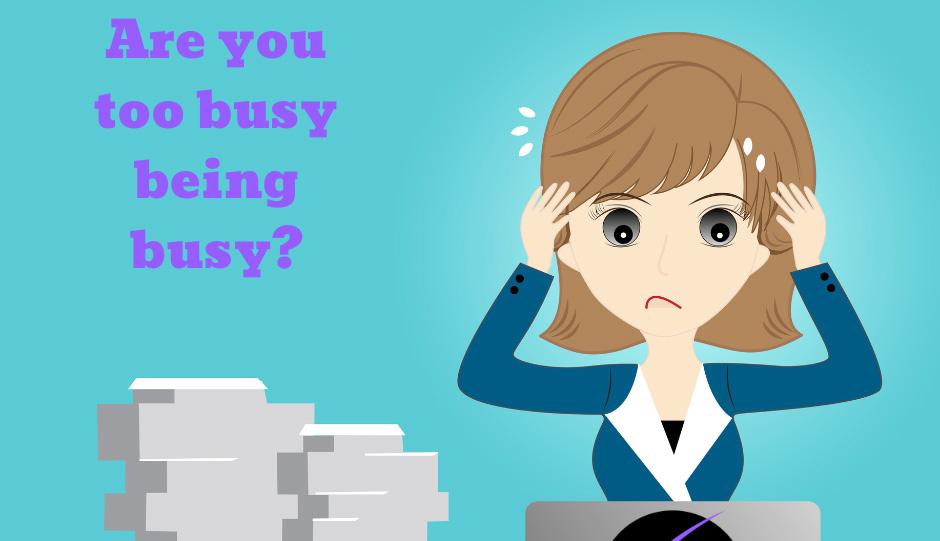 By Deb Mynett from CanDo VA Solutions
By Deb Mynett from CanDo VA Solutions
Are you a small business owner always onthe run?
Do you have heaps of balls in the air, fearing that one could drop at any moment?
Do you have a to-do list 10 kilometres long, feeling like the stress is eating you from the inside out?
Do you no longer feel the joy in running your business?
Late nights doing administration… Working too many hours… Neglecting your family, your life and worst of all, your self-care…
It’s time to wake up and smell the roses. Or, at the very least, entertain the idea of outsourcing the tasks that are holding you back from going where you want to go with your business.
If you run a small business and are tired of that sinking feeling of task overwhelm, then help is available.
Granted, it will take some effort and commitment on your part. It’s certainly not a set-and-forget scenario. But if you truly embrace the concept and can learn to cope with letting go, you will reap the rewards.
Analyse how much time you are spending on non-reve nue producing activities. Then, ask yourself what tasks you could outsource to free up your time.
I’m sure there are things you enjoy more than doing ad min. There are VAs out there waiting to serve you, with skills to meet just about any need.
Once you take the leap, patience will be required as you learn to work together, and your VA gets a handle on you, your business and the tasks at hand. Please persist as this will indeed be a game-changer. You just have to BELIEVE (and be open to change).
There is every chance that the way you do some things is not the best and most efficient way. So go with the flow and see what happens.
Don’t think about the “Why Nots.”
Instead, consider the “Why’s” – and all the benefits of outsourcing to free up your valuable time.
It doesn’t have to start with ‘a marriage’; you can dip your toe in the water with a first date and a couple of
hours help.
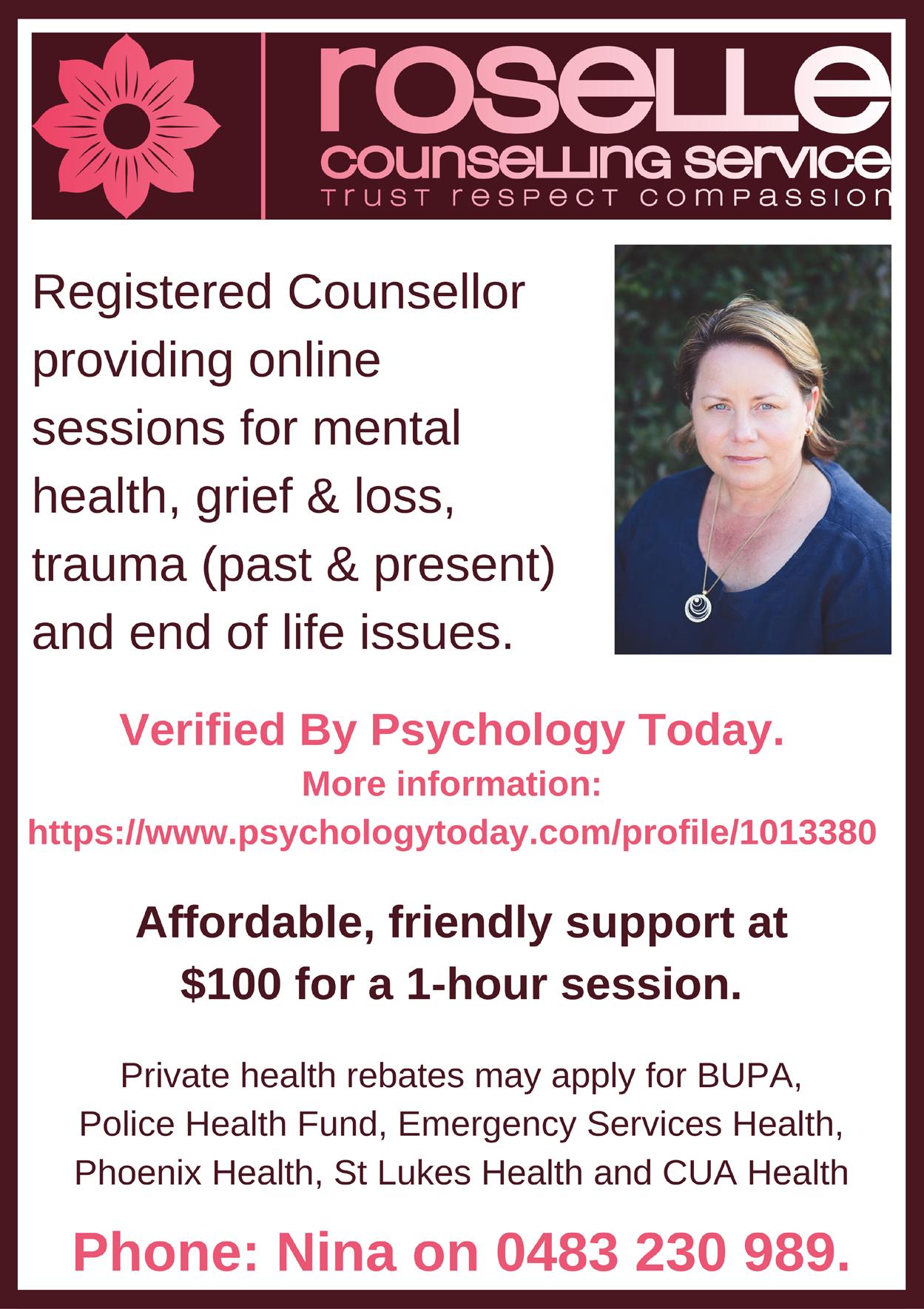
I’m Deb Mynett from CanDo VA Solutions. I’m a Virtual Administration Manager, and I help established small business owners keep their admin in order while they focus on what they do best.
Not sure if outsourcing is the right move for you right now? I’m happy to have a chat with anyone who would like to know more about how outsourcing can change your life and business.
Contact me via my website www.candovasolutions. com.au or give me a call on 0414 831 115.

